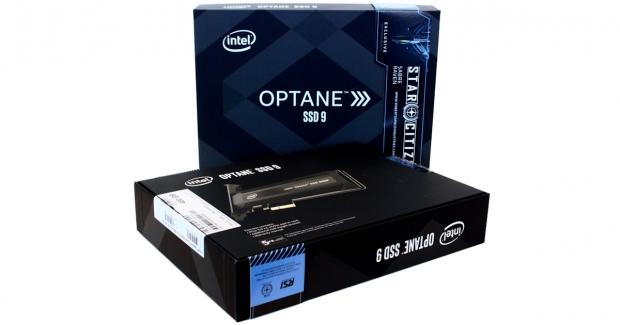
The Bottom Line
Introduction, Drive Specifications, Pricing & Availability
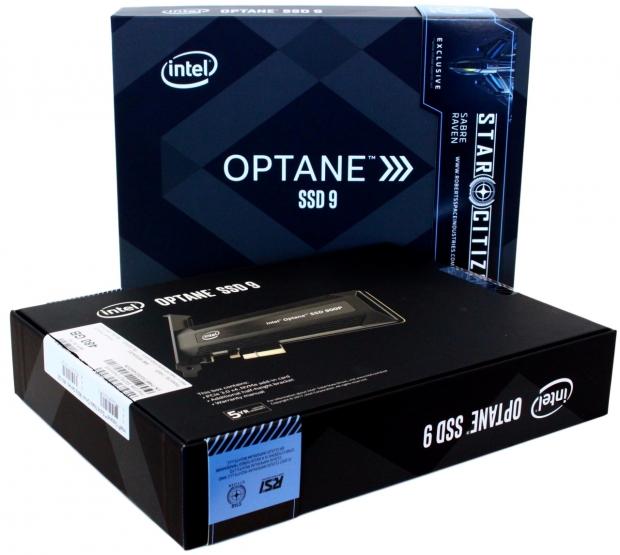
Two years ago, Intel/Micron introduced us to 3D XPoint memory media at a press event in San Francisco California. The performance claims presented were dazzling, to say the least. Since that day, we've been eagerly waiting to get a real 3D XPoint consumer SSD in our hands. Not a tiny caching module like Optane Memory, but a real retail enthusiast SSD with enough capacity to serve as a legitimate system disk. The wait is finally over. Intel's Optane SSD 900P is now hitting retail channels. We had heard rumors that the 900P would come to market at over $2 per gigabyte. Even at that price, we believed that if the 900P was able to live up to Intel's performance and endurance claims, it would certainly be worth the price of admission.
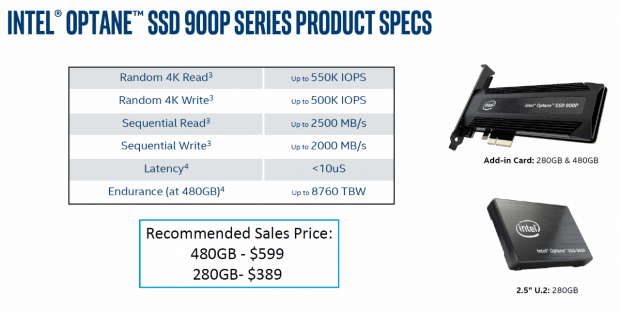
Needless to say, we're pleasantly surprised to see the Optane SSD 900P sporting an MSRP that is less than $1.50 per gigabyte. This is roughly 3x the price of high-end flash-based NVMe SSDs, but in this case, you get what you pay for. Optane 900P SSDs can deliver up to 7x the random read performance of the best flash-based SSDs at QD1, and are rated at about 10x the endurance of their flash-based counterparts. For many of you, that actually makes Optane the better overall value.
What is 3D XPoint memory media and why is it better than NAND? 3D XPoint memory is a joint venture between Intel and Micron (IMFT). The actual IP outside of the memory itself is separate proprietary technology. Neither company will disclose what makes 3D XPoint tick, but we believe it is a form of PCM (Phase Change Memory) technology. Intel calls their 3D XPoint technology "Optane." Optane consists of 3D XPoint memory, Intel memory and storage controllers, Intel interconnect IP and Intel software.
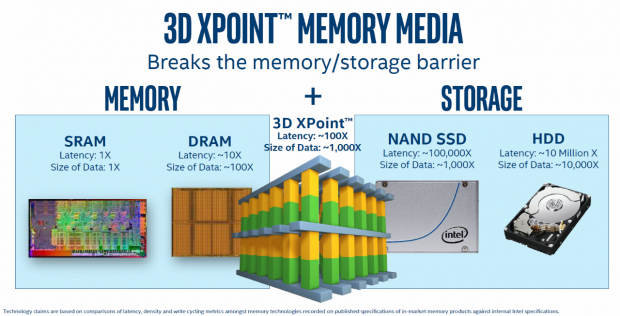
First and foremost, 3D XPoint is superior to NAND flash because it is much faster. 3D XPoint creates a new storage tier that falls between DRAM and NAND. On a cellular level, 3D XPoint memory media is 1000x faster than NAND. However, in the real-world, actual speed is limited by bus performance. So, you won't be getting 1000x faster performance than NAND flash-based SSDs can deliver due to interface limitations. 3D XPoint is also superior because it has at minimum 10x the endurance of NAND flash memory. Sustained performance is another huge advantage that 3D XPoint brings to the table. A 3D XPoint SSD runs at the same speed whether it is empty or full and under any condition. NAND-based SSDs get slower as they fill with data, and even slower when running sustained workloads. NAND SSDs rely on TRIM and GC (Garbage Collection) to maintain high performance, 3D XPoint SSDs do not.
Why do you need Optane? When evaluating SSDs for purchase, people tend to focus on sequential performance as the main indicator of how well an SSD will make their system perform. The bigger the number, the better the performance, right? Well, no that is almost always wrong. What matters most for overall system responsiveness is random read performance at low queue depths. Random read performance at low queue depths is where flash-based SSDs are at their weakest and where performance matters most. The difference between SATA SSDs and flash-based NVMe SSDs when reading random data at low queue depths is minimal at best. This is why for the most part, you cannot visibly differentiate between a PC that is running an on a SATA-based SDD or one running on a flash-based NVMe SSD. They both boot just as fast, and deliver virtually the same user experience as one-another. Optane technology is a game changer for one main reason - Intel's Optane 900P cranks out random read performance at low queue depths that can be as much as 7x better than the fastest flash-based NVMe SSDs. What this means in the real-world is very well illustrated by the following:
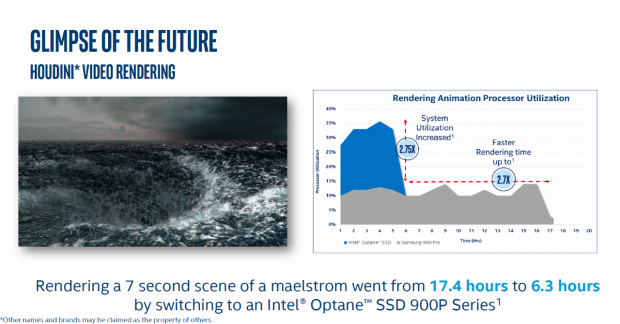
Rendering the same 7-second scene with a Samsung 960 Pro takes 2.7x longer than it does when using an Intel SSD 900P - 17.4 hours vs. 6.3 hours. That is indeed game-changing.
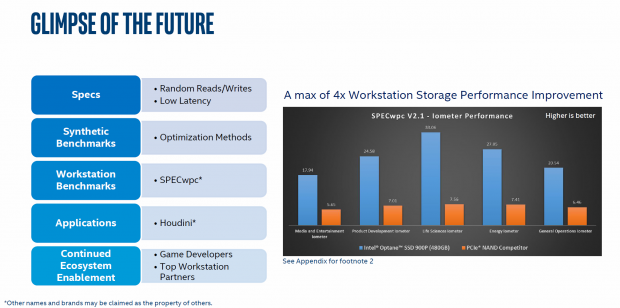
In a workstation environment, Optane 900P NVMe SSDs deliver up to 4x the storage performance of the fastest flash-based NVMe SSDs.
Having already tested Optane Memory caching SSD's we knew the 900P was set to redefine storage performance. Intel calls this giant performance leap "The New Normal." Even the taste of Optane we got from Optane Memory didn't prepare us for "The New Normal" that comes with a full-blown Optane SSD. It turns out that Optane SSDs live up to every claim made by Intel. The performance we got from our Optane 900P SSDs is mind-blowing. It is truly one of the few must-have pieces of hardware for any PC enthusiast that demands the very best.
If performance and endurance alone aren't enough to open your wallet, Intel has teamed up with RSI for the 900P launch.

Included with the Optane SSD 900P is an exclusive digital Star Citizen spaceship called the "Sabre Raven." The "Saber Raven" pictured above is exclusive for Optane SSD 900P owners. This is actually a huge value-add. Some Star Citizen spaceships can sell for literally thousands of dollars. The Sabre Raven isn't worth thousands, but it is worth hundreds. In fact, looking at eBay, we've already seen Sabre Raven codes being sold without the drive for $300 and up.
Specifications
Intel Optane SSD 900P 280GB & 480GB AIC PCIe NVMe SSD

- Sustained Sequential Read: up to 2,500 MB/s
- Sustained Sequential Write: up to 2,000 MB/s
- Max 4K Random Read Speed: up to 550,000 IOPS
- Max 4K Random Write Speed: up to 500,000 IOPS
- Endurance: 280GB up to 5,110 TBW
- Endurance: 480GB up to 8,760 TBW
- MTBF: 1.6 Million Hours
- Warranty: 5-Year Limited Warranty
MSRP: 280GB = $389.99 MSRP: 480GB = $599.99
Initially, the 900P series will be offered in two capacities and two form factors - U.2 and HHHL Add-In-Card (AIC). At this time, the U.2 form factor is only available at 280GB. The AIC form factor is available at both 280GB and 480GB capacity points. It is important to note that unlike flash-based SSDs, Optane SSDs don't rely on capacity for higher performance. The 280GB 900P is just as fast as the 480GB 900P. Another huge advantage Optane 900P SSDs have over their flash-based consumer counterparts is endurance. Currently, the best consumer flash-based SSDs slot in at about 1/2 drive-write per day of endurance. The SSD 900P Series is rated for ten drive-writes per day of endurance.
Drive Details
Intel Optane SSD 900P 280GB & 480GB AIC PCIe NVMe SSD
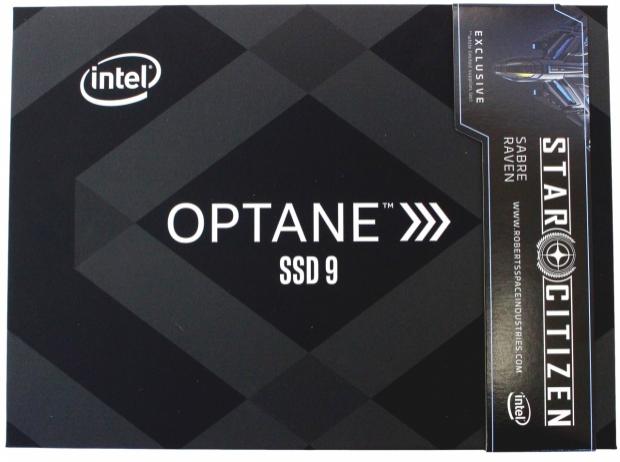
Intel's Optane SSD 900P packaging is one of the most attractive we've seen. The included Star Citizen spaceship is advertised on this side of the packaging.
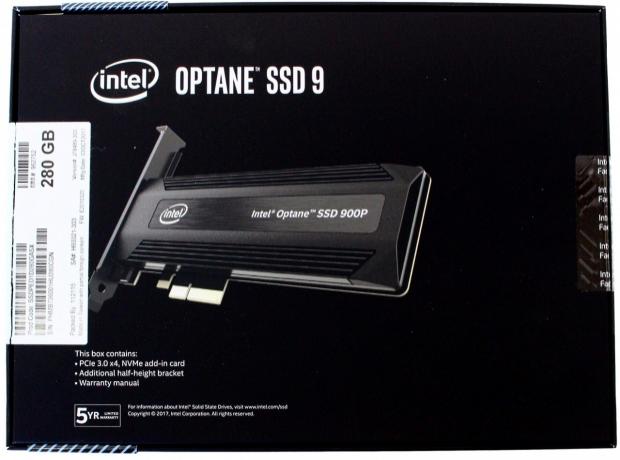
The back of the packaging features an image of the enclosed SSD, lists a bit of pertinent information about the enclosed SSD, its warranty, form factor, and included optional low-profile bracket.
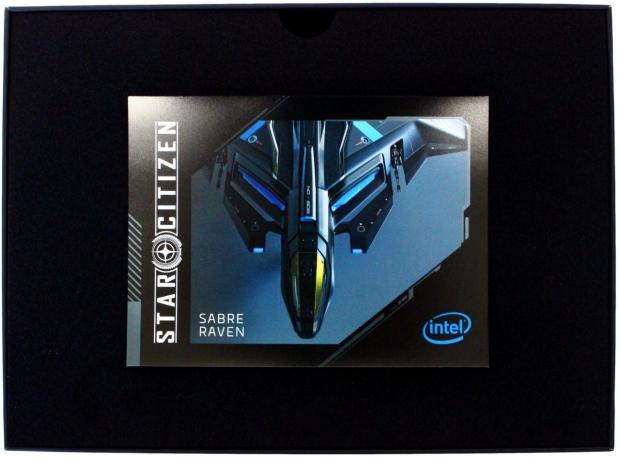
Opening the packaging reveals the Saber Raven. The code to obtain it is given on the back of the flyer pictured.
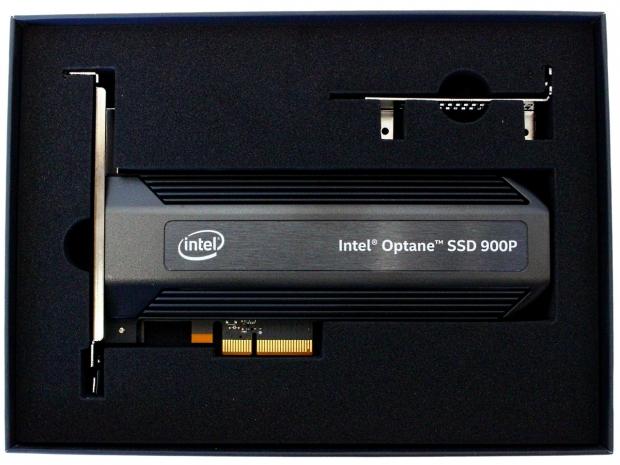
The drive and additional mounting bracket are cradled in dense foam rubber cut-outs.
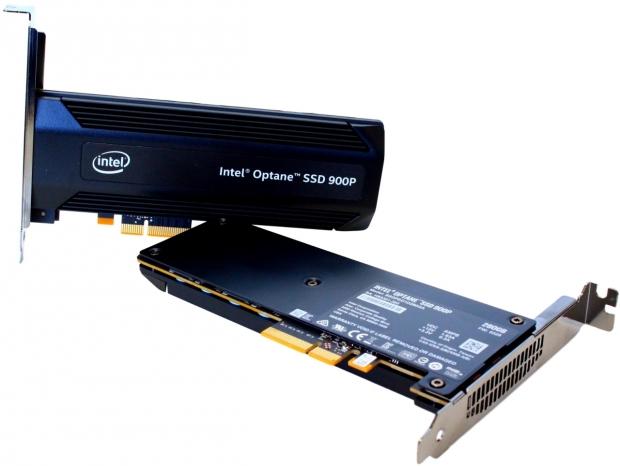
We will not be opening either of the drives for fear of damaging them. We can tell you what is on the inside though. The 900P is powered by the same 7-channel Intel NVMe controller that is found on the Optane SSD DC P4800X enterprise SSD. The 280GB model is populated with (21) 16GB 3D XPoint memory packages 14x16GB front and 7x16GB rear - 336GB in total. The 480GB is populated with (28) 3D XPoint memory packages 7x16GB+7x32GB front and 14x16GB rear - 560GB in total. The 900P is a DRAM-less design. Optane memory media does not require overprovisioning space, so we figure it is used for ECC and redundancy.
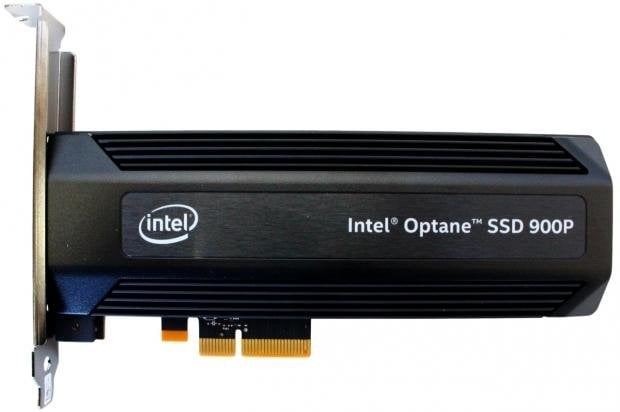
The front of the drive is covered by a full-length aluminum heat sink.
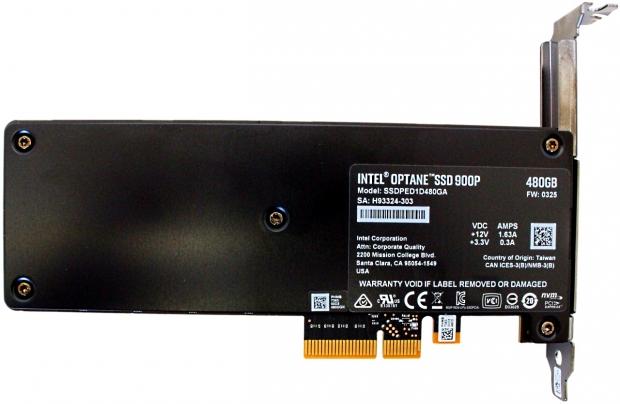
The rear of the drive is covered by protective metal plate. There is a manufacturer label located close to the mounting bracket.
Test System Setup, Drive Properties & SSD Toolbox
Jon's Consumer PCIe SSD Review Test System Specifications
- Motherboard: ASRock Z270 Taichi - Buy from Amazon
- CPU: Intel Core i7 7700K @ 5.0GHz - Buy from Amazon / Read our review
- Cooler: Swiftech H2O-320 Edge - Buy from Amazon / Read our review
- Memory: Corsair Vengeance LPX DDR4 16GB 3000MHz - Buy from Amazon
- Video Card: Onboard Video
- Case: IN WIN X-Frame - Buy from Amazon / Read our review
- Power Supply: Seasonic Platinum 1000 Watt Modular - Buy from Amazon / Read our review
- OS: Microsoft Windows 10 Professional 64-bit - Buy from Amazon
- Drivers: MS Win 10 NVMe driver
We would like to thank ASRock, Crucial, Intel, Corsair, RamCity, IN WIN, and Seasonic for making our test system possible.
Drive Properties
Intel Optane SSD 900P 280GB AIC PCIe NVMe SSD OS Disk 75% Full
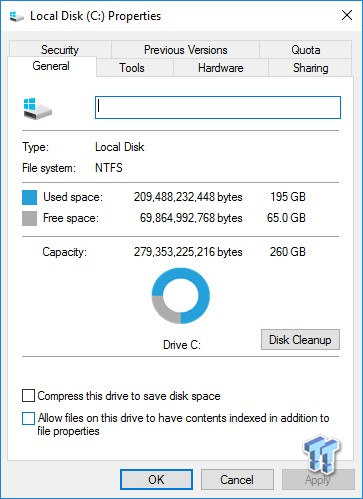
Intel Optane SSD 900P 480GB AIC PCIe NVMe SSD OS Disk 75% Full
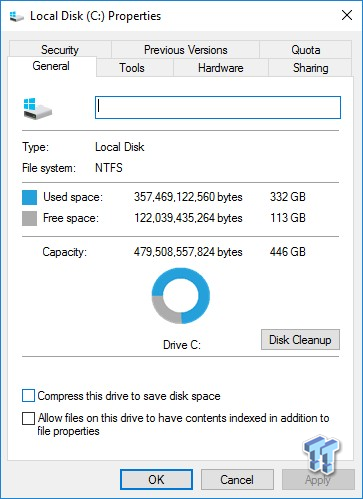
The majority of our testing is performed with the test subject as our boot volume. Our boot volume is 75% full for all OS Disk "C" drive testing to replicate a typical consumer OS volume implementation. We feel that most of you will be utilizing your SSDs for your boot volume and that presenting you with results from an OS volume is more relevant than presenting you with empty secondary volume results.
System settings: Cstates and Speed stepping are both disabled in our systems BIOS. Windows High-Performance power plan is enabled. We are utilizing Windows 10 Pro 64-bit OS (Build 14393) for testing except for our MOP (Maxed-Out Performance) benchmarks where we switch to Windows Server 2008 & 2012 R2 64-bit. Empty Windows 10 benchmark screenshots will also be shown on our MOP page.
Additionally, we decided to run an MS SoftRAID (Striped) volume utilizing both drives. Benchmark screenshots of our results are posted on our MOP page. It's not bootable, but it still performs much better than VROC.
Please note: When comparing our results to those of other review sites, look at page 10 Maxed Out Performance-Windows 10 which is done with the disk empty.
Benchmark screenshots will be shown 280GB model first followed by the 480GB model.
In choosing our test pool, we selected the fastest flash-based SSDs on the market (regardless of capacity) to take on Intel's Optane 900P
Note: Intel has a dedicated NVMe driver for the 900P. It does increase performance slightly over the native Win 10 NVMe driver, but we opted not to use it.
Synthetic Benchmarks - ATTO & Anvil Storage Utilities
ATTO
Version and / or Patch Used: 3.05
ATTO is a timeless benchmark used to provide manufacturers with data used for marketing storage products. When evaluating ATTO performance, we focus on the drive's performance curve.
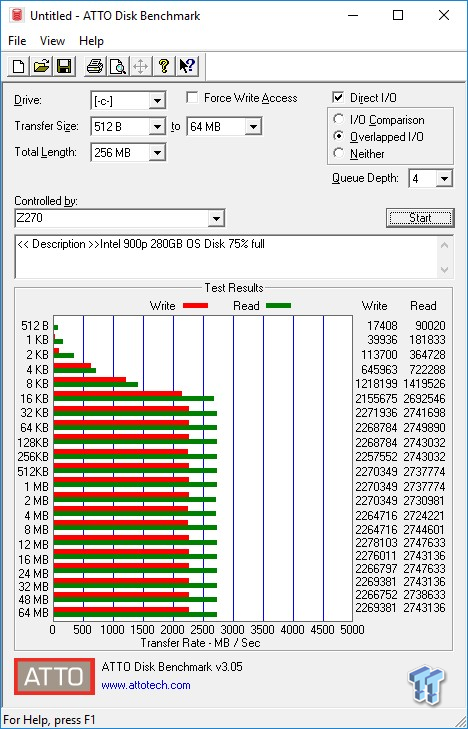
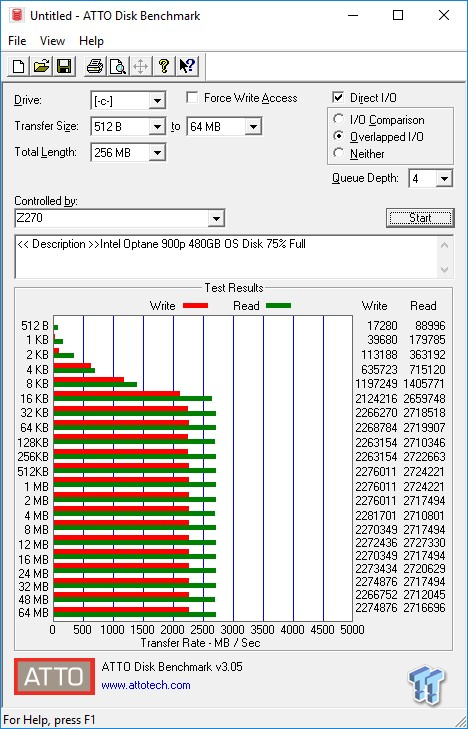
Both capacities perform almost identically as expected. Full performance is achieved at 32KB transfers.
Sequential Write
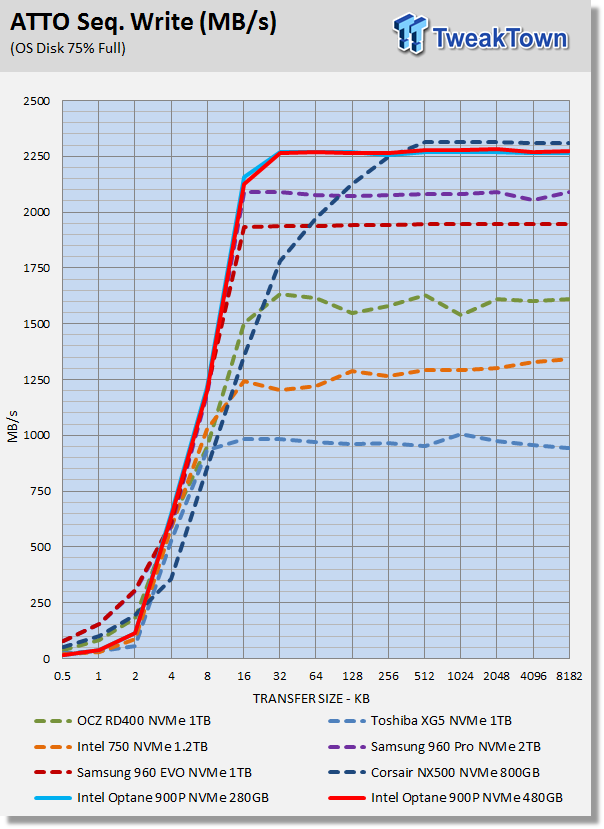
Overall, the 900P displays the best performance curve of the bunch.
Sequential Read
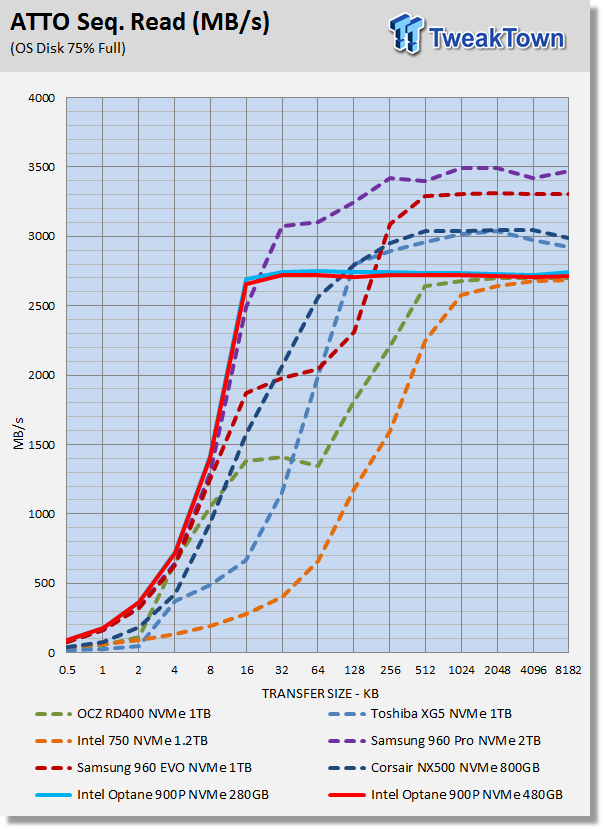
Overall, the 900P is just edged out by the 960 Pro. There are other SSDs in our test pool that achieve higher transfer rates on the top end, but their performance curve is inferior.
Anvil Storage Utilities
Version and / or Patch Used: 1.1.0
Anvil's Storage Utilities is a storage benchmark designed to measure the storage performance of SSDs. The Standard Storage Benchmark performs a series of tests; you can run a full test or just the read or write test, or you can run a single test, i.e., 4K QD16. When evaluating performance with Anvils, we focus on total score. When evaluating NVMe SSDs, we are typically looking for a minimum total score of over 10K. We place a greater importance on read performance than write performance.
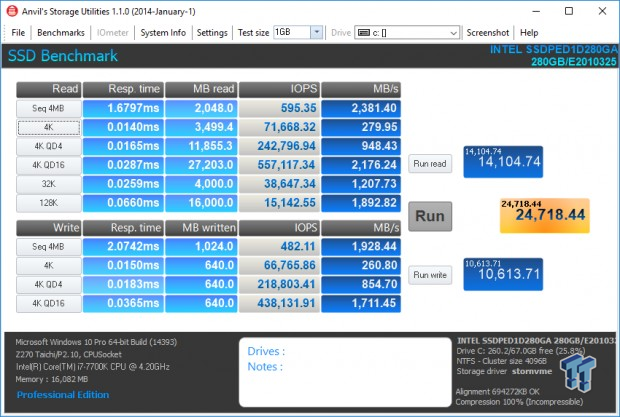
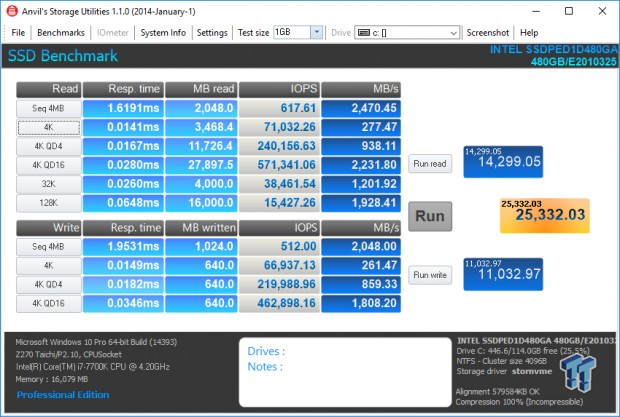
Scoring
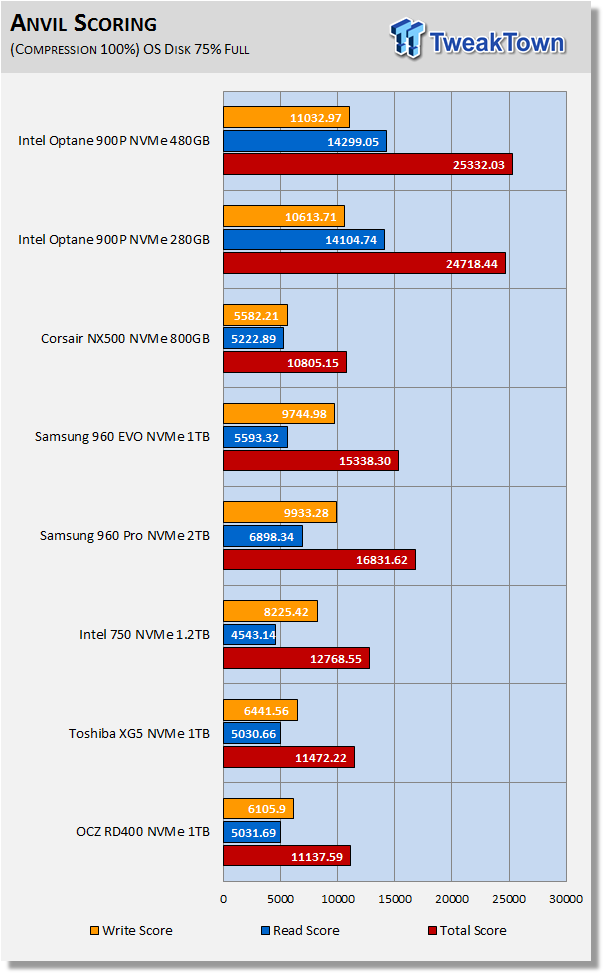
And this is where the domination begins. The 900P crushes the competition, doing so where it matters most - random read performance. Look at the read score; it is 2-3x better than the other drives in our test pool.
(Anvil) Read IOPS through Queue Depth Scale

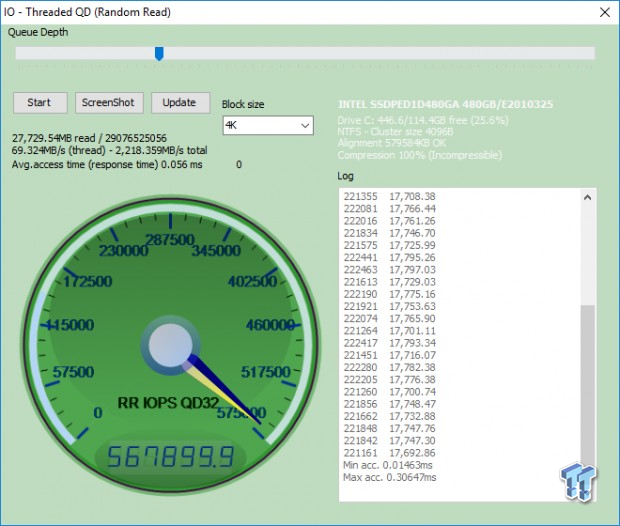
No problem exceeding factory specs with both capacities.
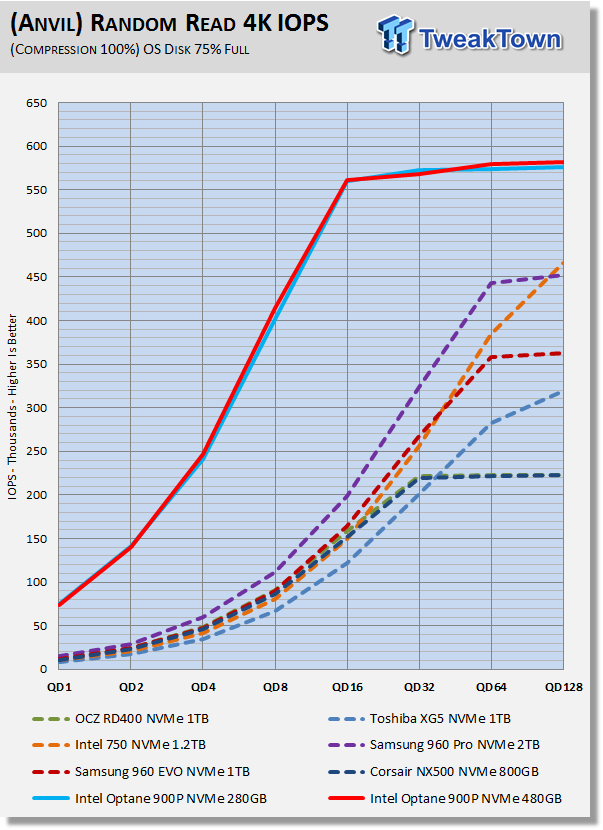
This graph perfectly illustrates why you need Optane. The 900P is cranking out a minimum of 5x the random read performance of our flash-based contenders at low queue depths. Keep in mind that random read performance at QD1-2 is by far the most important metric in relation to system performance.
(Anvil) Write IOPS through Queue Scale
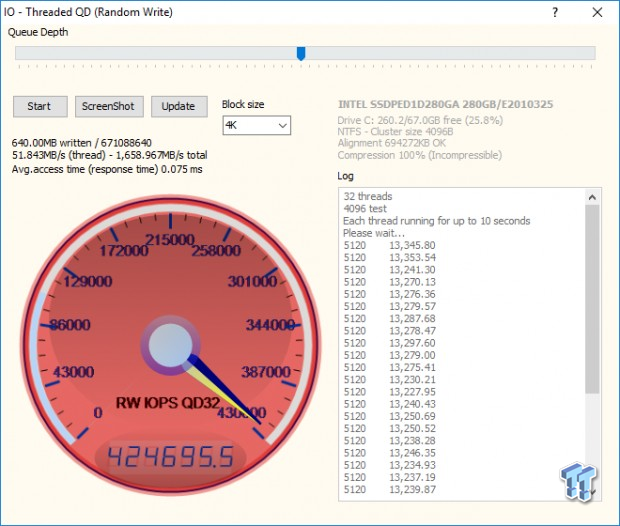
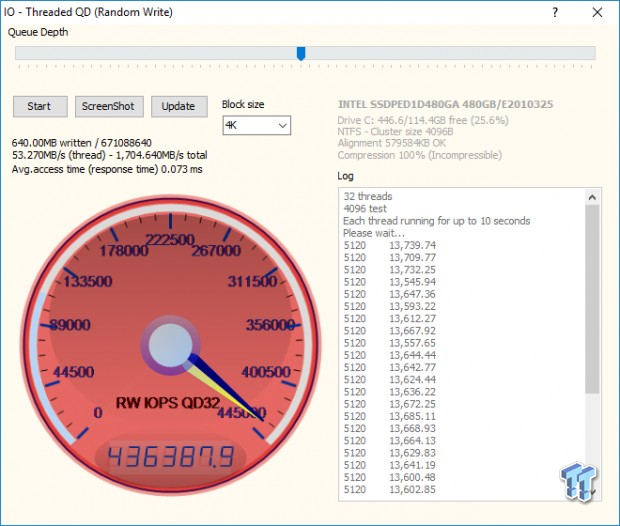
Random write IOPS at QD32 with a partition on the drive fall short of factory specs.
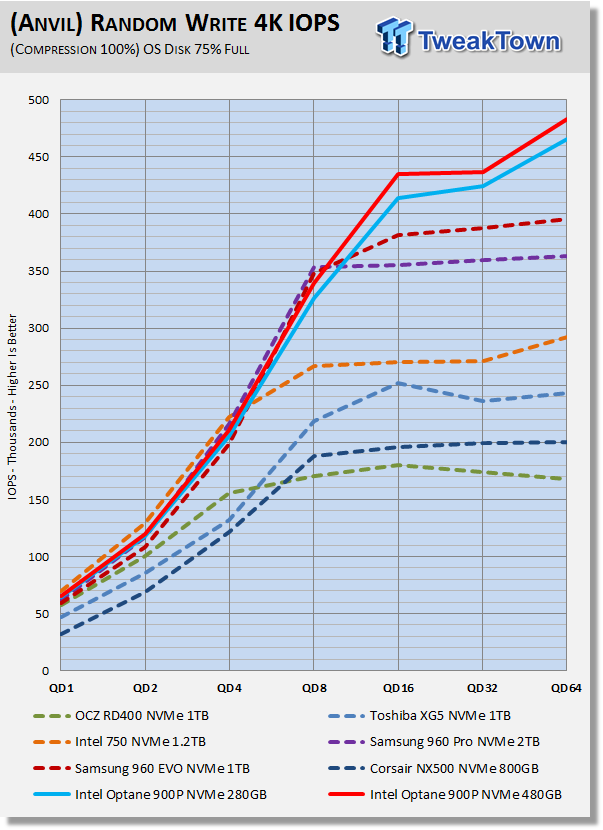
This is a tough one to call, but we will give the win to Optane. The 900P hangs in there with the best of them at queue depths of up to 8, but flies past the competition at queue depths above 8.
Synthetic Benchmarks – CrystalDiskMark & AS SSD
CrystalDiskMark
Version and / or Patch Used: 3.0 Technical Preview
CrystalDiskMark is disk benchmark software that allows us to benchmark 4k and 4k queue depths with accuracy. Note: Crystal Disk Mark 3.0 Technical Preview was used for these tests since it offers the ability to measure native command queuing at QD4. When evaluating CDM results, we focus on 4K random performance at QD1 and QD4.
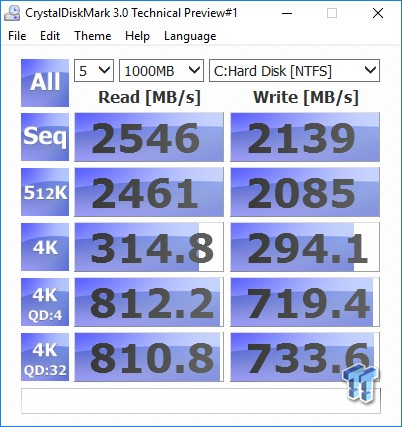

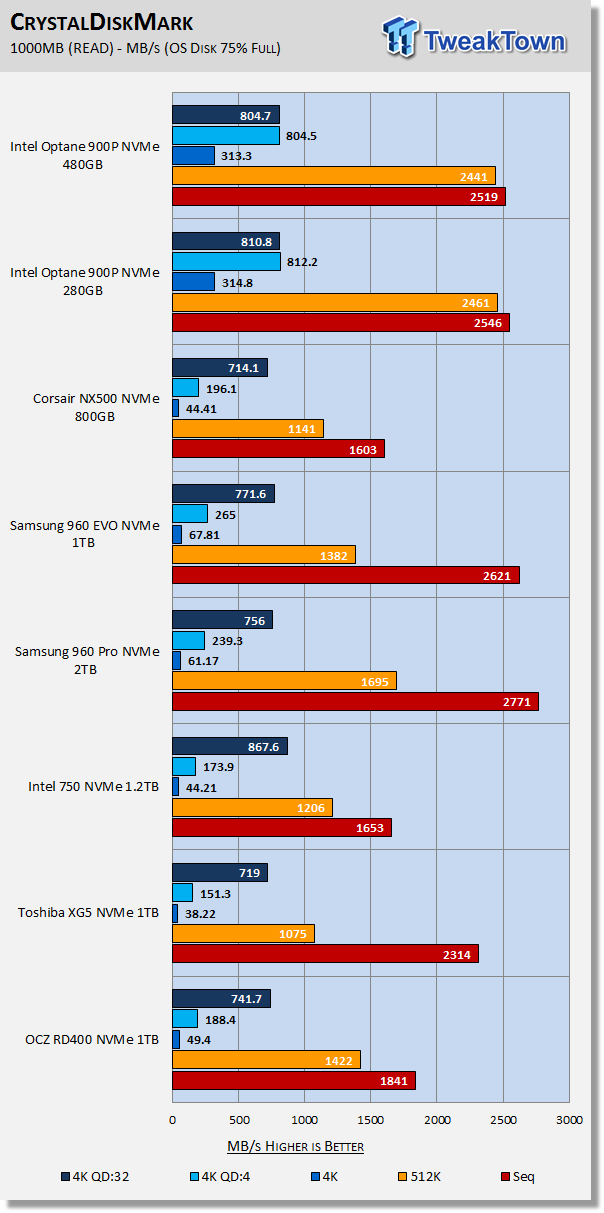
Focusing in on QD1 and QD4 we see the 900P obliterating the competition. This is where it matters most. At QD1 the 900P is delivering 4.6x the performance of our previous champion the 960 EVO 1TB.
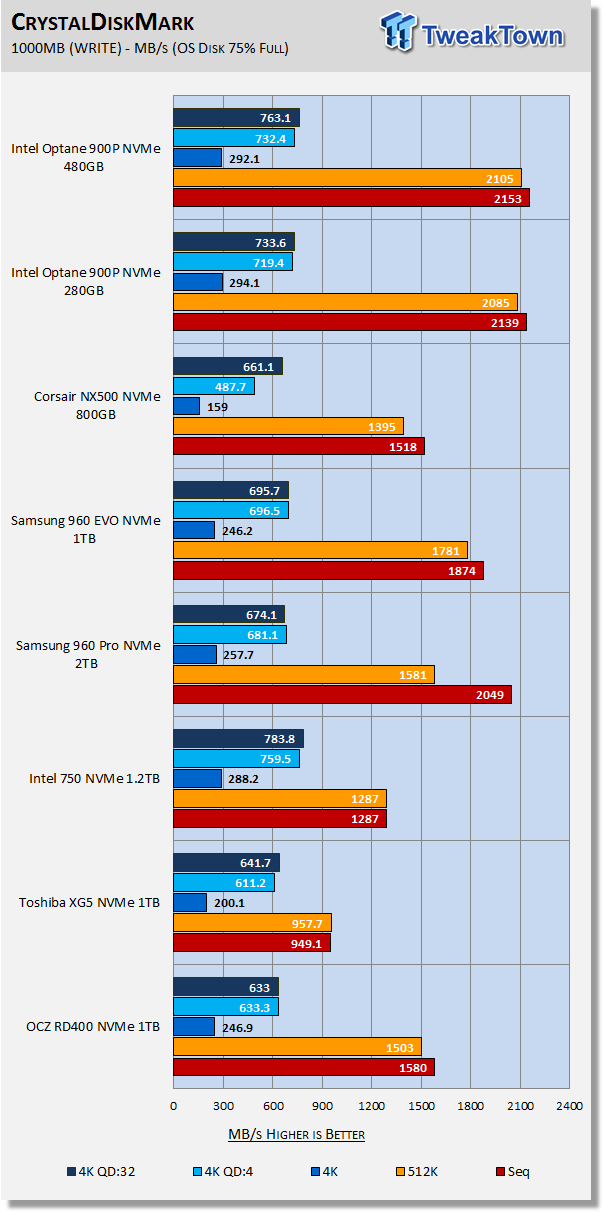
Our focus is mainly on QD1 and QD4 random performance. The 900P beats the competing SSDs at QD1 and comes in second to Intel's 1.2TB 750 at QD4. However, we cannot overlook Optane's sequential and 512K performance, because it is the best we've seen to date.
AS SSD
Version and / or Patch Used: 1.8.5611.39791
AS SSD determines the performance of SSDs. The tool contains four synthetic as well as three practice tests. The synthetic tests are to determine the sequential and random read and write performance of the SSD. We evaluate AS SSD performance in terms of overall score. We are looking for a minimum score of 2,000 when evaluating NVMe SSDs.
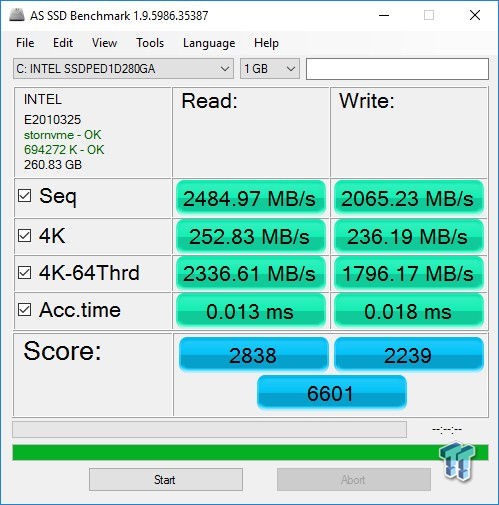
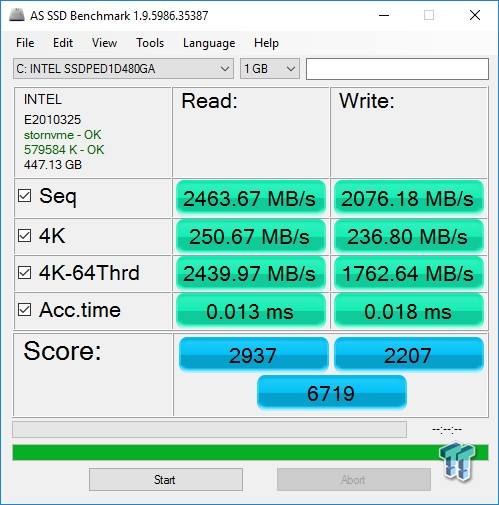

AS SSD is a demanding test - that is unless you are running a 900P. Optane dominates the competition, scoring a minimum of 50% higher than the next closest competitor.
Benchmarks (OS) - Vantage, PCMark 7, PCMark 8 & SYSmark 2014 SE
Moderate Workload Model
We categorize these tests as indicative of a moderate workload environment.
PCMark Vantage - Hard Disk Tests
Version and / or Patch Used: 1.2.0.0
The reason we like PCMark Vantage is because the recorded traces are played back without system stops. What we see is the raw performance of the drive. This allows us to see a marked difference between scoring that other trace-based benchmarks do not exhibit. An example of a marked difference in scoring on the same drive would be empty vs. filled vs. steady state.
We run Vantage three ways. The first run is with the OS drive 75% full to simulate a lightly used OS volume filled with data to an amount we feel is common for most users. The second run is with the OS volume written into a "Steady State" utilizing SNIA's consumer guidelines. Steady-state testing simulates a drive's performance similar to that of a drive that been subjected to consumer workloads for extensive amounts of time. The third run is a Vantage HDD test with the test drive attached as an empty, lightly used secondary device.
OS Volume 75% Full - Lightly Used
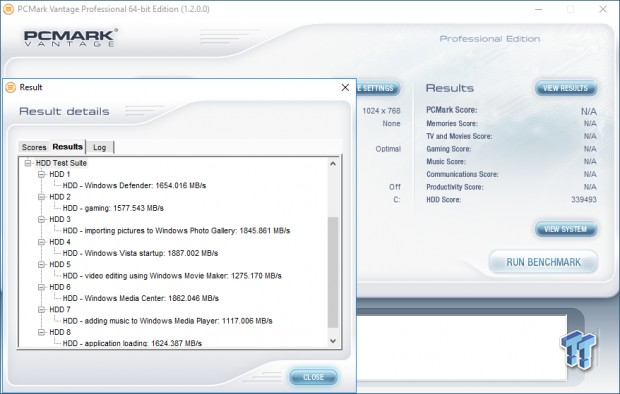
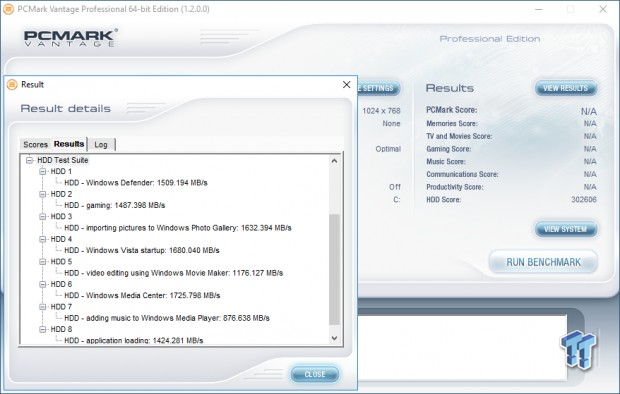
OS Volume 75% Full - Steady State
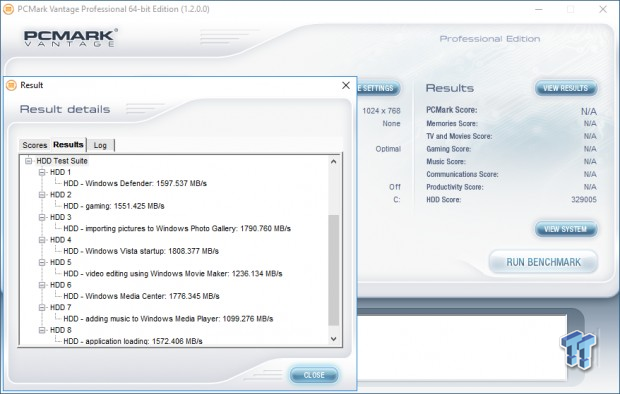
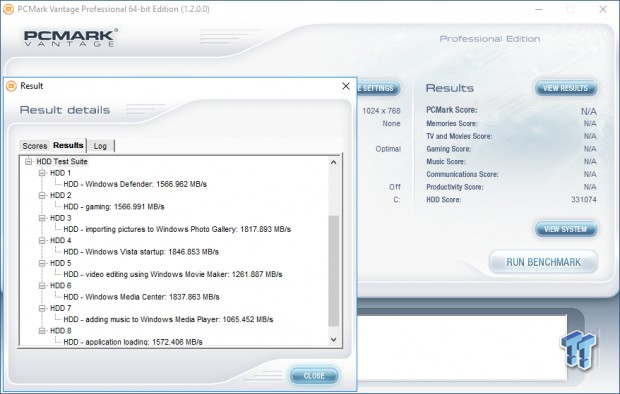
Secondary Volume Empty - FOB
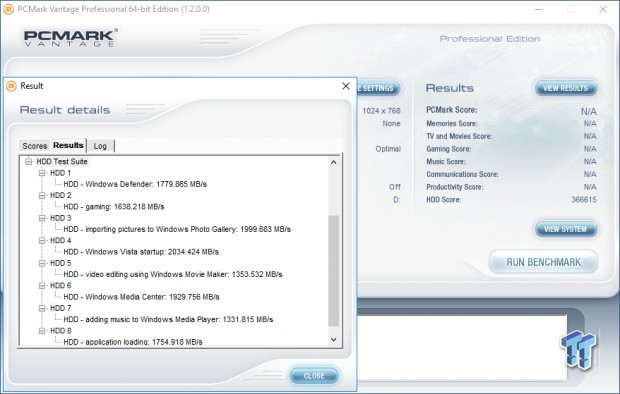
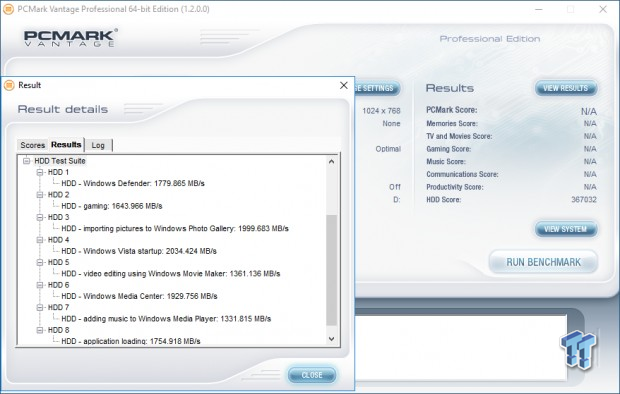
Typically, there is a big difference between an empty drive, one that's 75% full/used, and one that's in a steady state. Not so with Optane. Scoring is similar no matter what the state the drive is in.
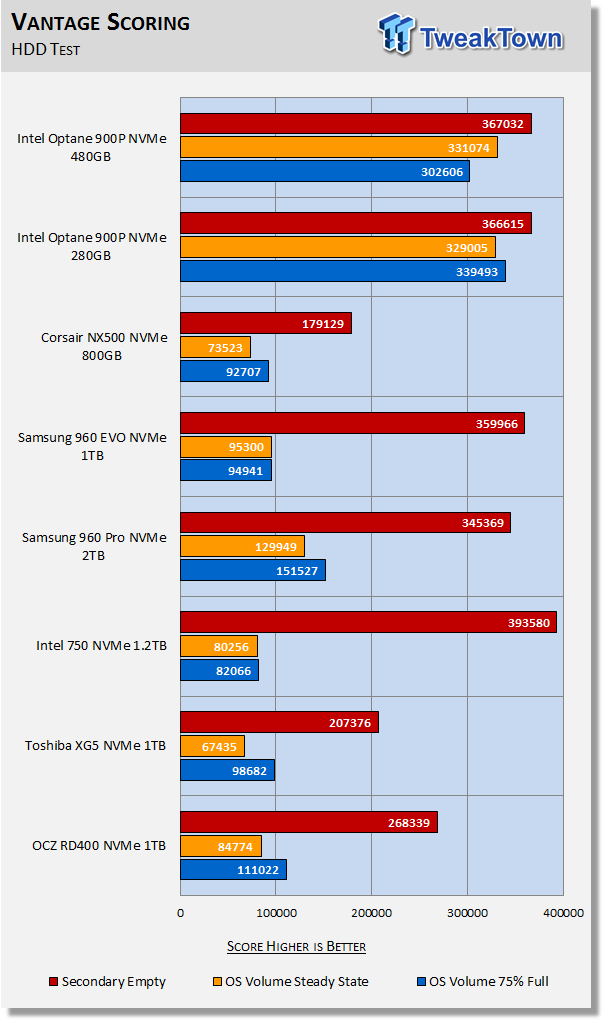
The important scores to pay attention to are "OS Volume Steady State" and "OS Volume 75% full." These two categories are most important because they are indicative of typical of consumer user states. When a drive is in a steady state, it means garbage collection is running at the same time it's reading/writing.
Steady-state only applies to flash-based SSDs, not Optane. The Optane drive's score at minimum 100% better than the 960 Pro at 75% full and steady-state. Look at the Intel 750. This is a perfect example of 3D XPoint's superiority over NAND. The 750 actually scores higher than the 900P when empty, but look at what happens when data is on the drive. The Optane 900P outscores the 750 by roughly 400% when data is on the drive.
PCMark 7 - System Storage
Version and / or Patch Used: 1.4.0
We will look to Raw System Storage scoring for evaluation because it's done without system stops and, therefore, allows us to see significant scoring differences between drives. When evaluating NVMe SSDs, we are looking for a minimum score of 11,000.
OS Volume 75% Full - Lightly Used
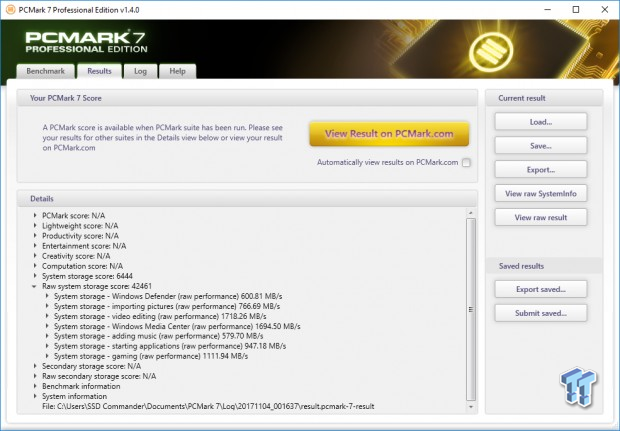
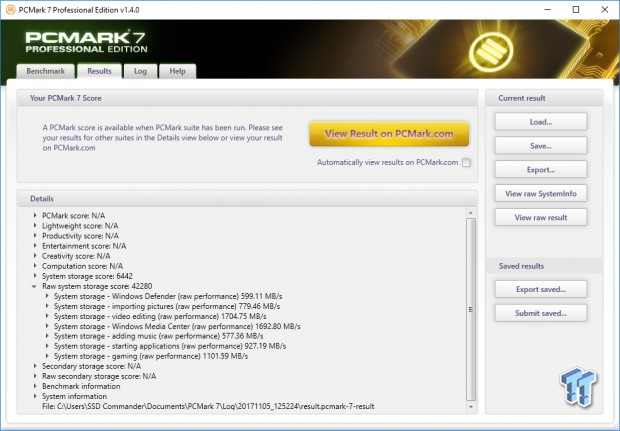
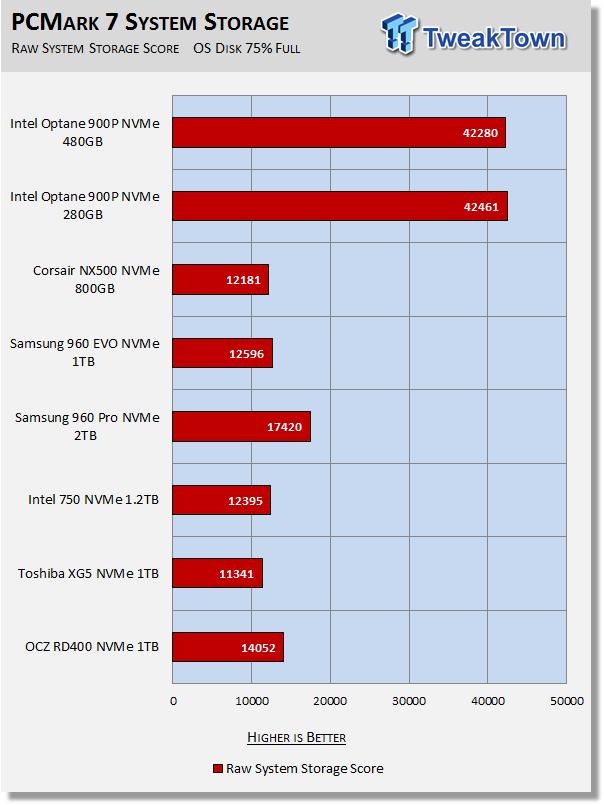
The 900P lays waste to the competition yet again. The 900P is delivering almost 4x our minimum score of 11K.
PCMark 8 - Storage Bandwidth
Version and / or Patch Used: 2.4.304
We use PCMark 8 Storage benchmark to test the performance of SSDs, HDDs, and hybrid drives with traces recorded from Adobe Creative Suite, Microsoft Office, and a selection of popular games. You can test the system drive or any other recognized storage device, including local external drives. Unlike synthetic storage tests, the PCMark 8 Storage benchmark highlights real-world performance differences between storage devices.
OS Volume 75% Full - Lightly Used
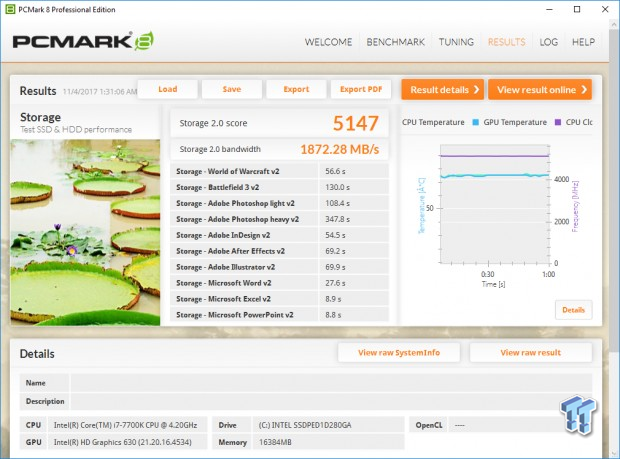
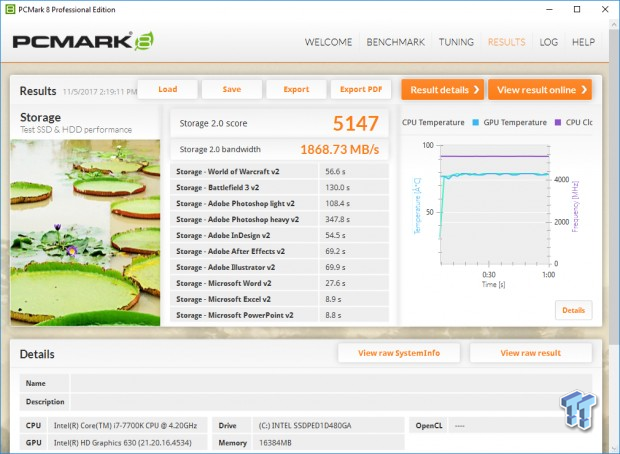
PCMark 8 is the most intensive moderate workload simulation we run. Concerning moderate consumer type workloads, this test is what we consider the best indicator of a drive's performance.
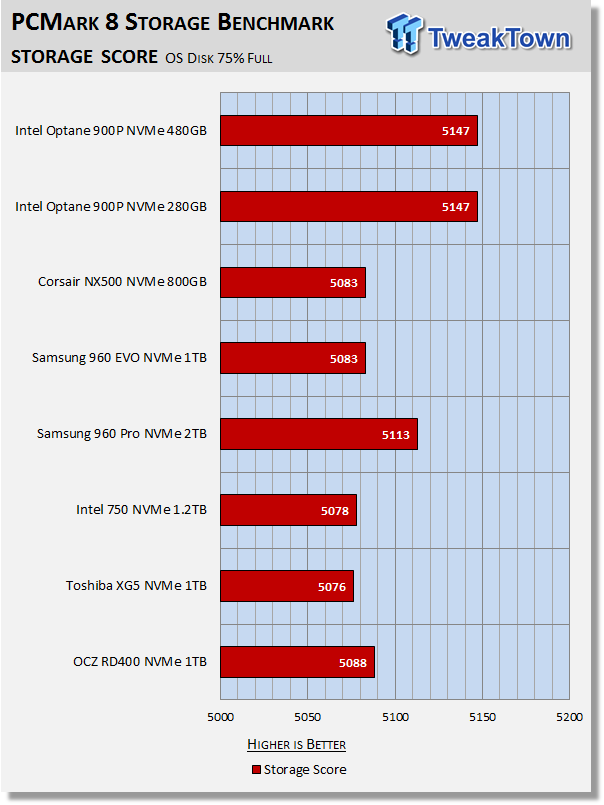
When comparing storage scores, it is important to keep in mind that a few points are a big deal.
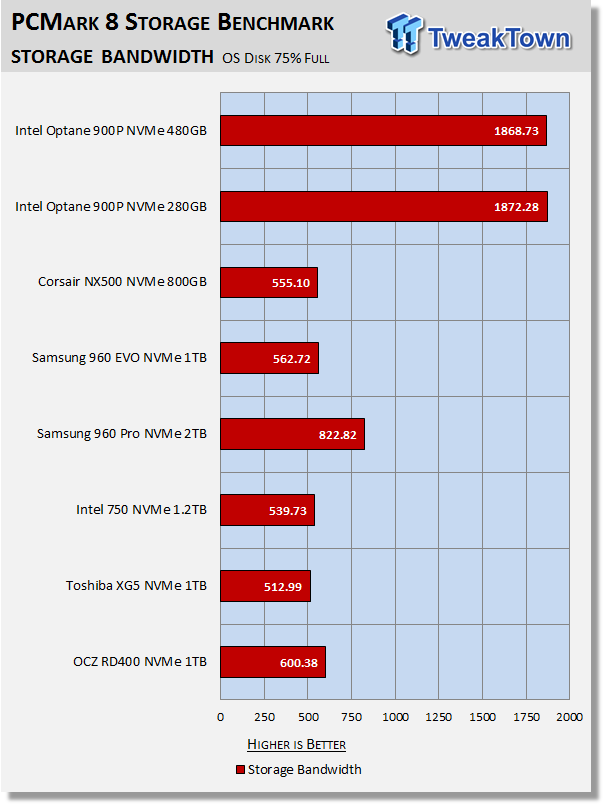
Storage bandwidth really highlights what the 900P can do in a more discernable way than scoring does. What it does is crush the competition.
BAPCo SYSmark 2014 SE Application Performance
Version and / or Patch Used: 2.0.0.70
SYSmark 2014 SE is considered the gold standard for testing system performance because it is an application based benchmark. This test gives us the ultimate in real-world results because it utilizes actual applications running on the system, instead of playing back recorded traces. If you want to know what kind of impact a particular SSD will have on your system's overall performance; this test will show you.
Our systems are much more powerful than the calibration system (1000-point baseline) used by BAPCo, so we ran an OCZ TL100 120GB SATA III SSD to establish a comparison point relative to our test systems. We will be running this test going forward, and we will add drives to our chart as we test them.
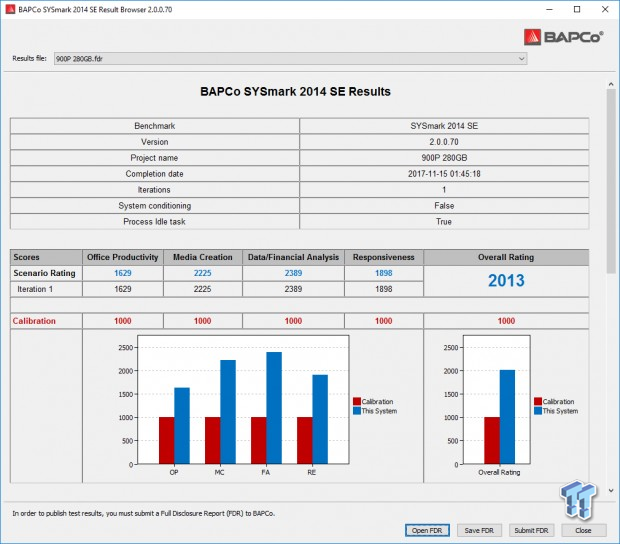
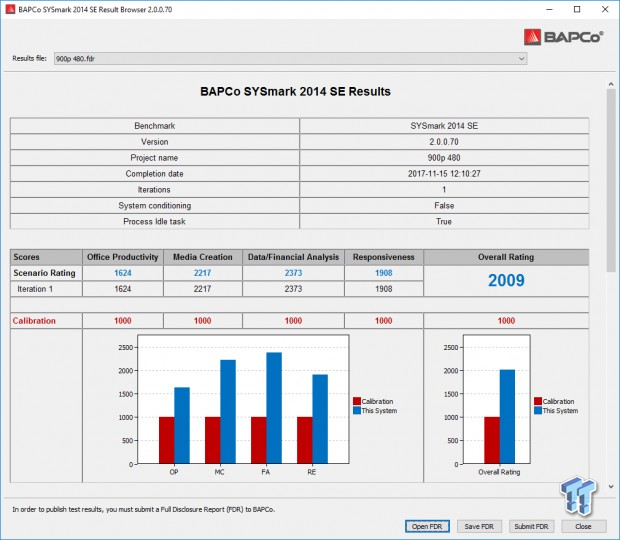
It is important to keep in mind that with SYSmark 2014 SE a few points are a big deal when comparing one drive to another on the same platform.
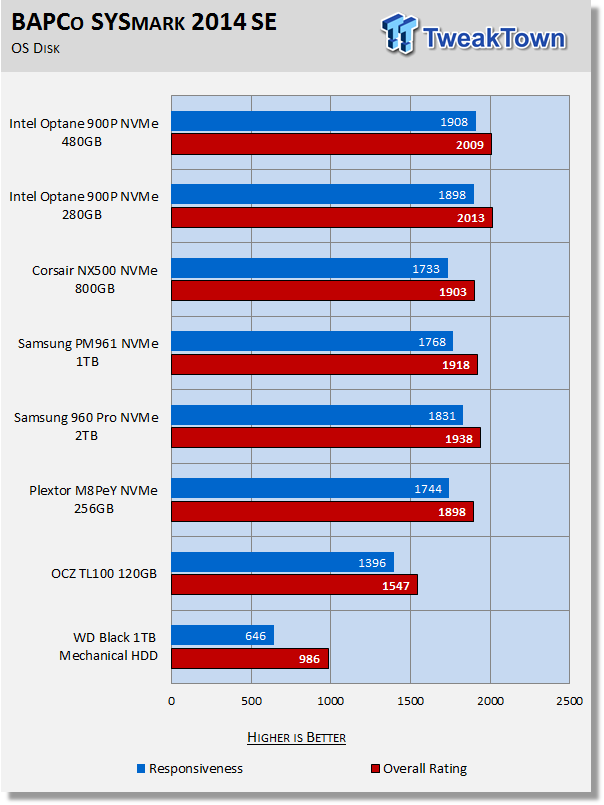
This lineup is a bit different than the others we've used for our test pool to this point. This is because these are the only SSDs we've run on our new Z270 storage testing platform. With all other benchmarks, there is very little difference between our Z170 and Z270 platforms. However, with SYSMark there is a marked difference due to increased CPU performance.
10 points is a big deal, and the 900P is beating the world's fastest flash-based consumer SSD by a whopping 75 points.
Benchmarks (Secondary) - IOPS, Response & Transfer Rate
Iometer – Maximum IOPS
Version and / or Patch Used: Iometer 2014
We use Iometer to measure high queue depth performance. (No Partition)
Max IOPS Read
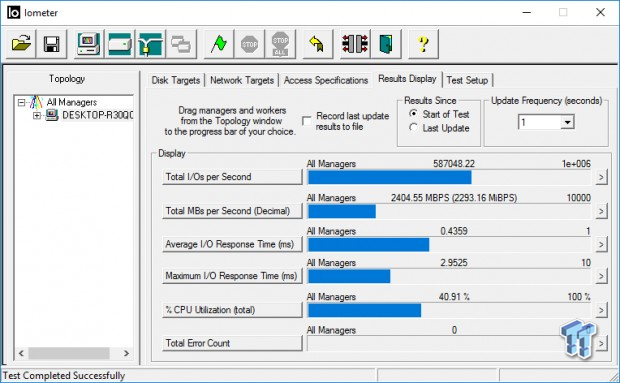
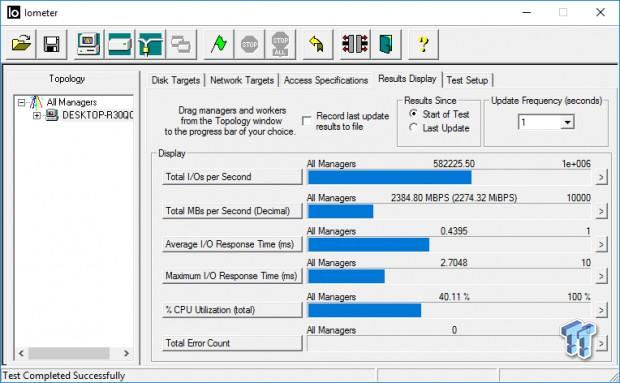
Max IOPS Write
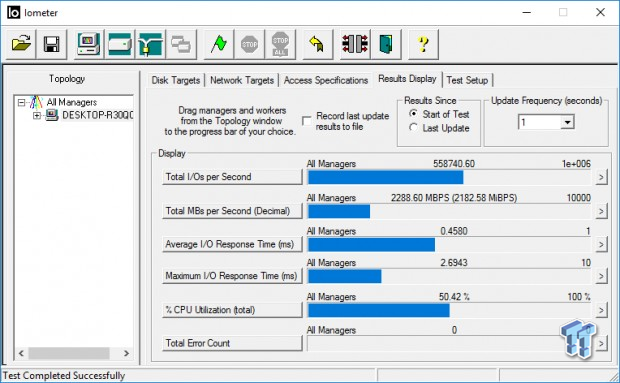
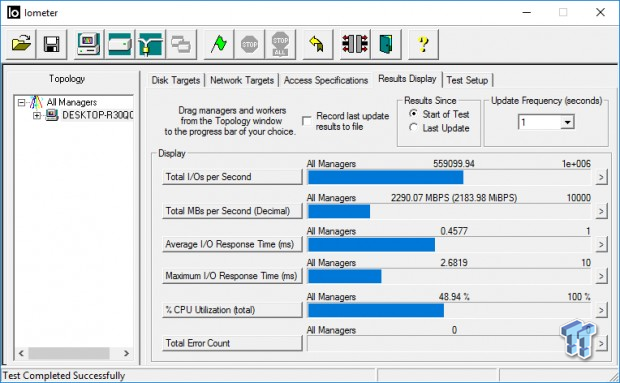
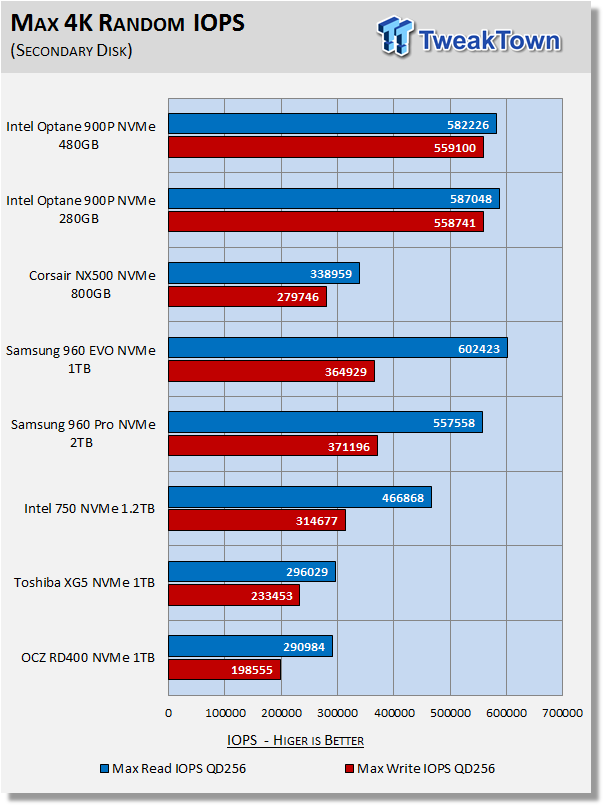
We test NVMe SSDs using eight threads at QD32 (QD256). We do this because we want to see what the drive can generate at its maximum attainable queue depth.
Iometer – Disk Response
Version and / or Patch Used: Iometer 2014
We use Iometer to measure disk response times. Disk response times are measured at an industry accepted standard of 4K QD1 for both write and read. Each test runs twice for 30 seconds consecutively, with a 5-second ramp-up before each test. We partition the drive/array as a secondary device for this testing.
Avg. Write Response
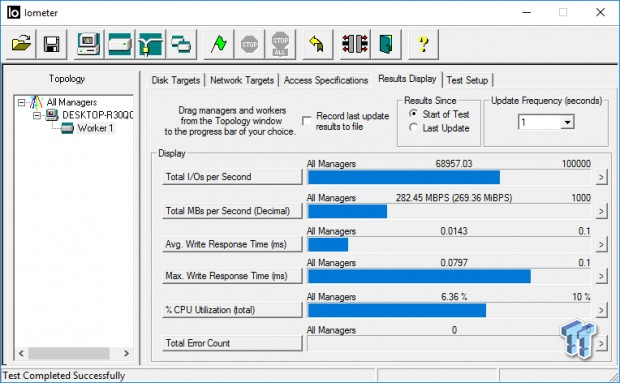
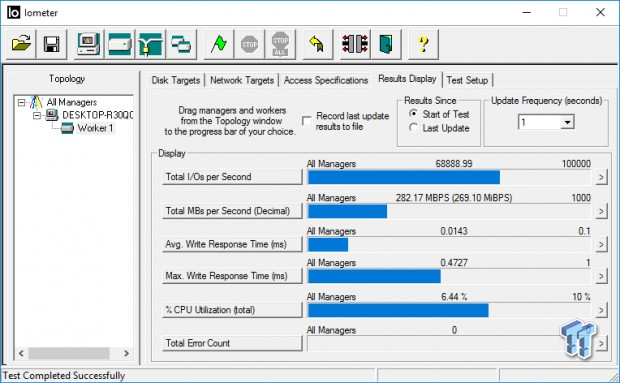
Avg. Read Response
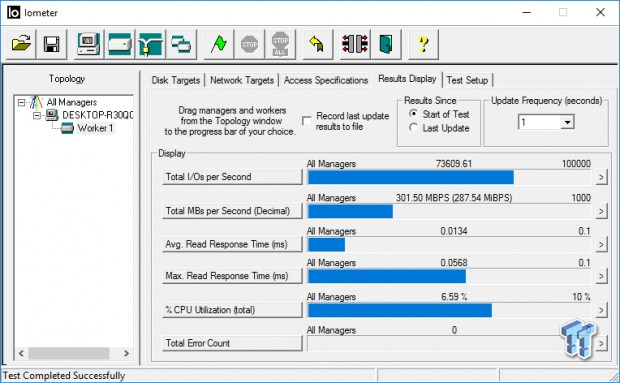
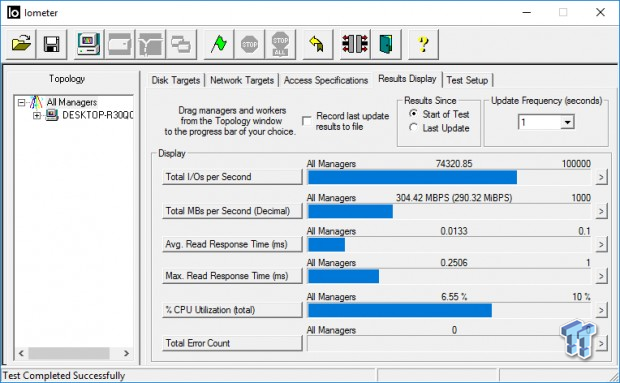
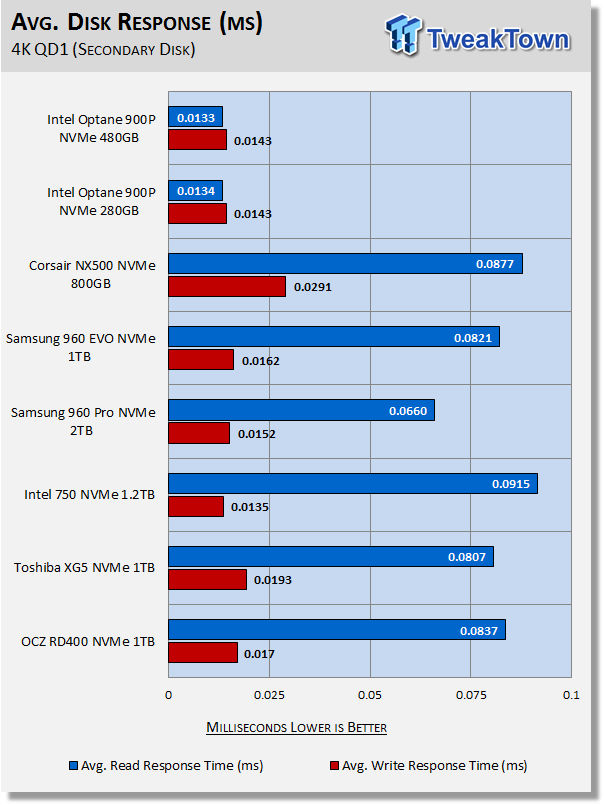
And there you have it. This is why the 900P is the world's most responsive SSD. Look at the 900P's read response. It is roughly 6x better than the 960 Pro.
DiskBench – Transfer Rate
Version and / or Patch Used: 2.6.2.0
We use DiskBench to time a 28.6GB block (9,882 files in 1,247 folders) composed primarily of incompressible sequential and random data as it's transferred from our Toshiba RD400 1TB NVME SSD to our test drive. We then read from a 6GB zip file that's part of our 28.6GB data block to determine the test drive's read transfer rate. Our system is restarted prior to the read test to clear any cached data, ensuring an accurate test result.
Write Transfer Rate
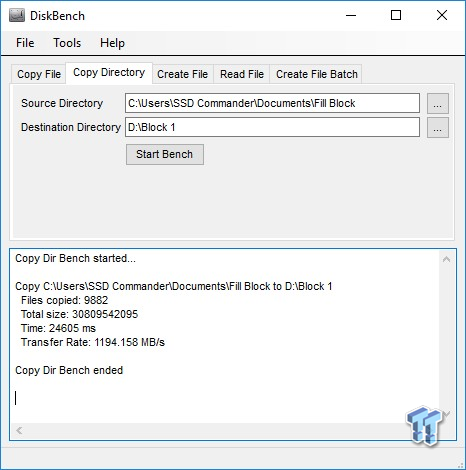
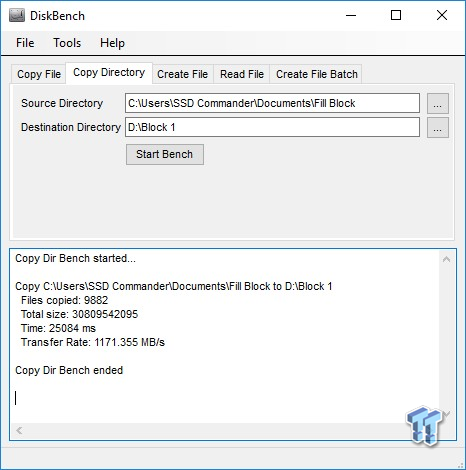
Read Transfer Rate
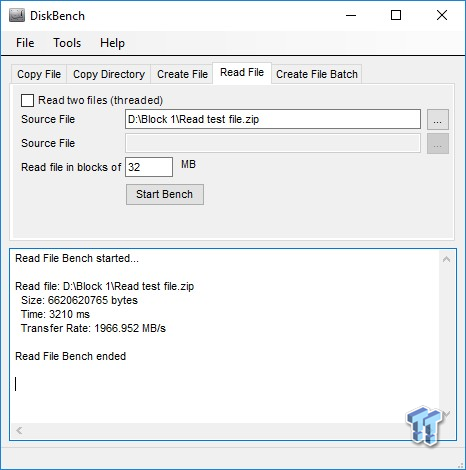
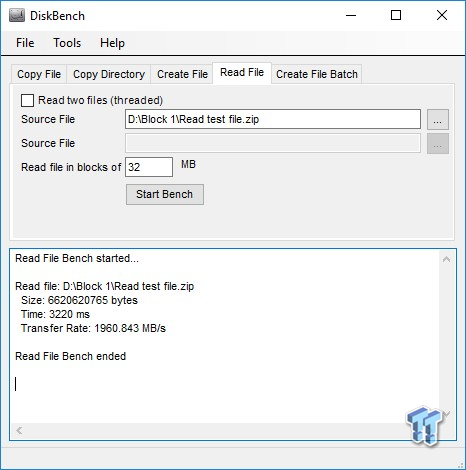
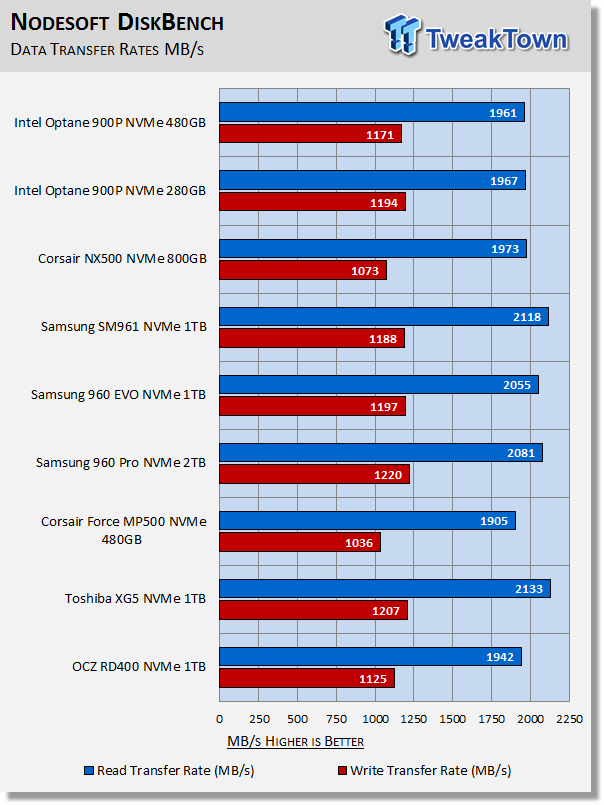
We recently upgraded our test system to Windows 10 build 14393. With that upgrade, write transfer rates almost doubled. The reason for this, as far as we know, is that CPU power switching modes have been relaxed on the latest version of Windows 10. We included the NVMe drives we've tested to date on this build of Windows 10. If you needed a good reason to upgrade to a newer version of Windows 10; this is a good reason.
There is enough sequential data in our data block that the 900P doesn't win this test.
Benchmarks (Secondary Volume) – PCMark 8 Extended
Futuremark PCMark 8 Extended
Heavy Workload Model
PCMark 8's consistency test simulates an extended duration heavy workload environment. PCMark 8 has built-in, command line executed storage testing. The PCMark 8 Consistency test measures the performance consistency and the degradation tendency of a storage system.
The Storage test workloads are repeated. Between each repetition, the storage system is bombarded with a usage that causes degraded drive performance. In the first part of the test, the cycle continues until a steady degraded level of performance has been reached. (Steady State)
In the second part, the recovery of the system is tested by allowing the system to idle and measuring the performance after 5-minute long intervals. (Internal drive maintenance: Garbage Collection (GC)) The test reports the performance level at the start, the degraded steady-state, and the recovered state, as well as the number of iterations required to reach the degraded state and the recovered state.
We feel Futuremark's Consistency Test is the best test ever devised to show the true performance of solid state storage in an extended duration heavy workload environment. This test takes on average 13 to 17 hours to complete and writes somewhere between 450GB and 14,000GB of test data depending on the drive. If you want to know what an SSDs steady-state performance is going to look like during a heavy workload, this test will show you.
Here's a breakdown of Futuremark's Consistency Test:
Precondition phase:
1. Write to the drive sequentially through up to the reported capacity with random data.
2. Write the drive through a second time (to take care of overprovisioning).
Degradation phase:
1. Run writes of random size between 8*512 and 2048*512 bytes on random offsets for 10 minutes.
2. Run performance test (one pass only).
3. Repeat 1 and 2 for 8 times, and on each pass increase the duration of random writes by 5 minutes.
Steady state phase:
1. Run writes of random size between 8*512 and 2048*512 bytes on random offsets for 50 minutes.
2. Run performance test (one pass only).
3. Repeat 1 and 2 for 5 times.
Recovery phase:
1. Idle for 5 minutes.
2. Run performance test (one pass only).
3. Repeat 1 and 2 for 5 times.
Storage Score, Storage Bandwidth
PCMark 8's Consistency test provides a ton of data output that we use to judge a drive's performance.
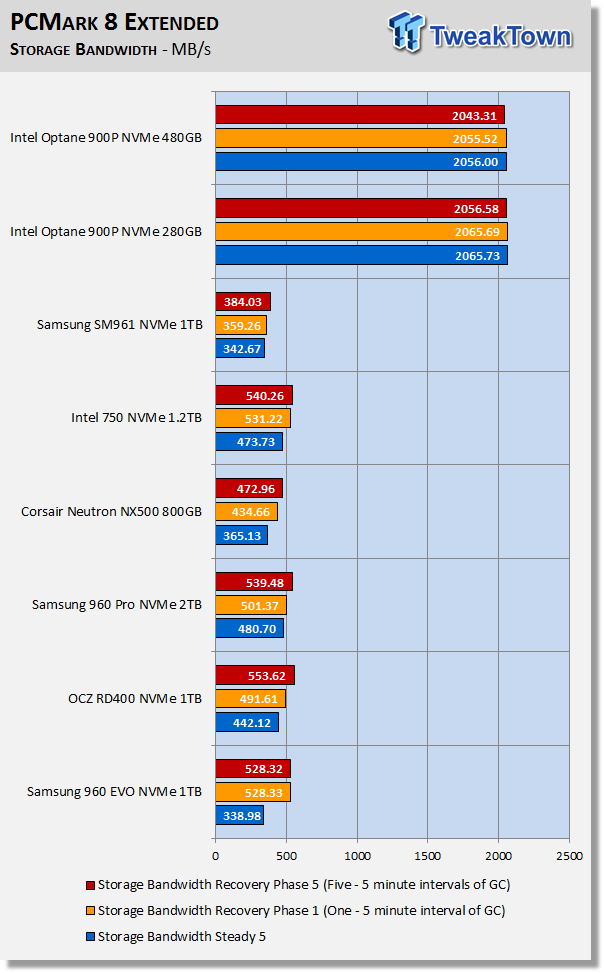
We consider steady-state bandwidth (the blue bar) our test that carries the most weight in ranking a drive/arrays heavy workload performance. Performance after Garbage Collection (GC) (the orange and red bars) is what we consider the second most important consideration when ranking a drive's performance.
Unlike NAND, 3D XPoint is unaffected by degrade, steady-state or recovery. It's all the same for Optane. Absolute domination.
Storage Bandwidth Per Phase
We chart our test subject's storage bandwidth as reported at each of the test's 18 trace iterations. This gives us a good visual perspective of how our test subjects perform as testing progresses. This chart sheds more light on how the drives perform as they progress through the testing phases.
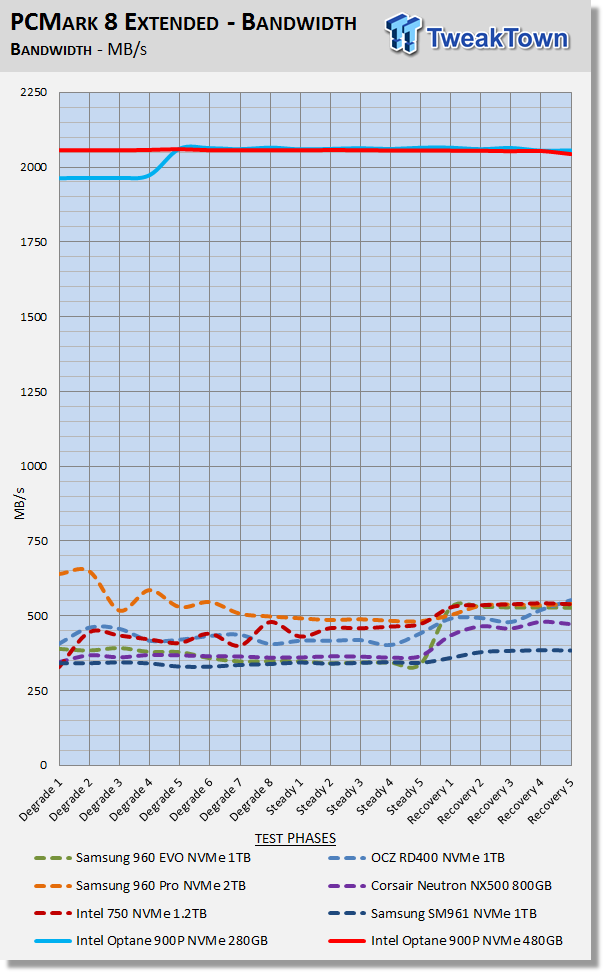
Total Access Time (Latency)
We chart the total time the disk is accessed as reported at each of the test's 18 trace iterations. This helps shed some light on how the drive performs at each of the 18 phases of this test.
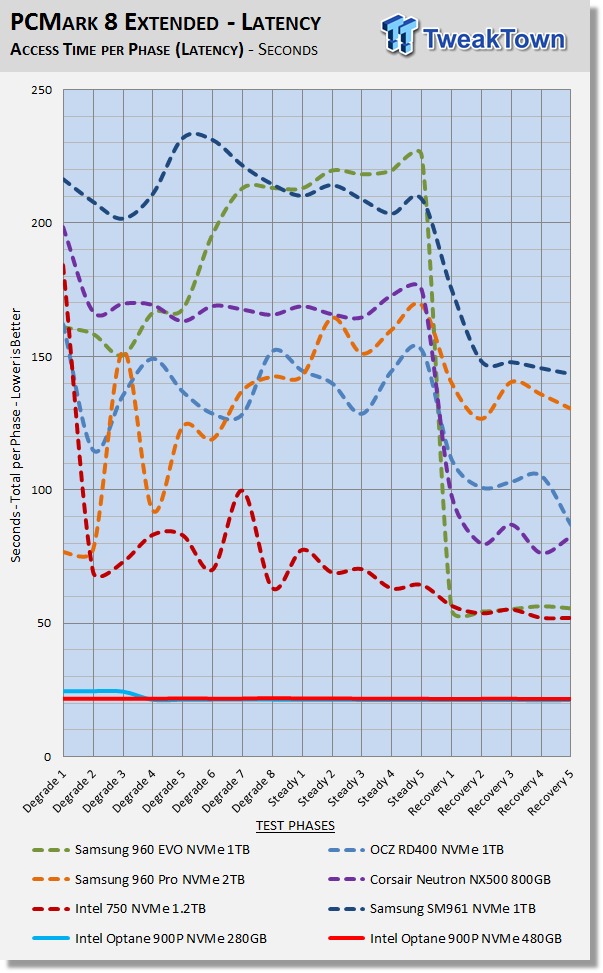
Disk Busy Time
Disk Busy Time is how long the disk is busy working. We chart the total time the disk is working as reported at each of the tests 18 trace iterations.
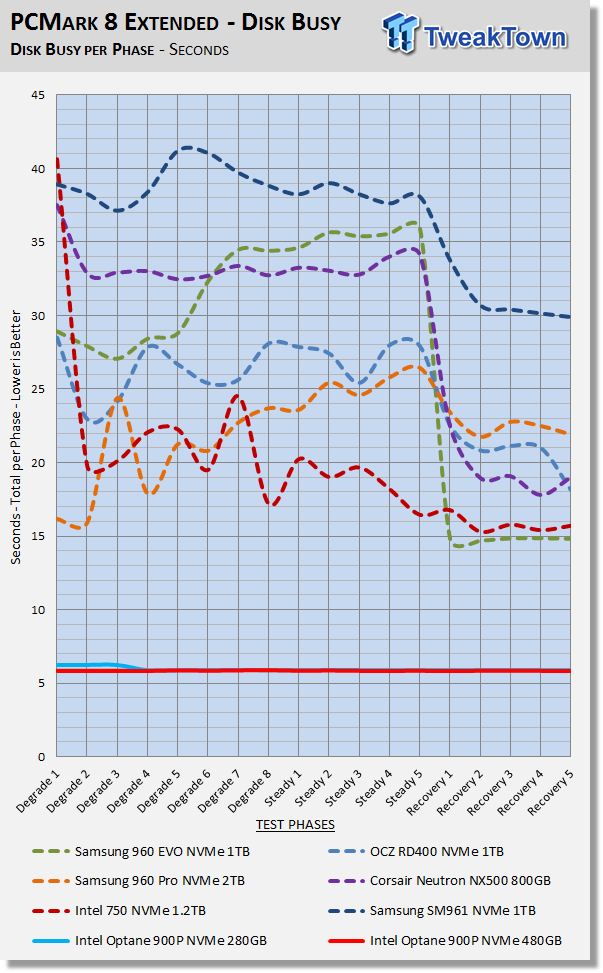
Data Written
We measure the total amount of random data that our test drive/array is capable of writing during the degradation phases of the consistency test. Pre-conditioning data is not included in the total. The total combined time that degradation data is written to the drive/array is 470 minutes. This can be very telling. The better a drive/array can process a continuous stream of random data; the more data will be written.
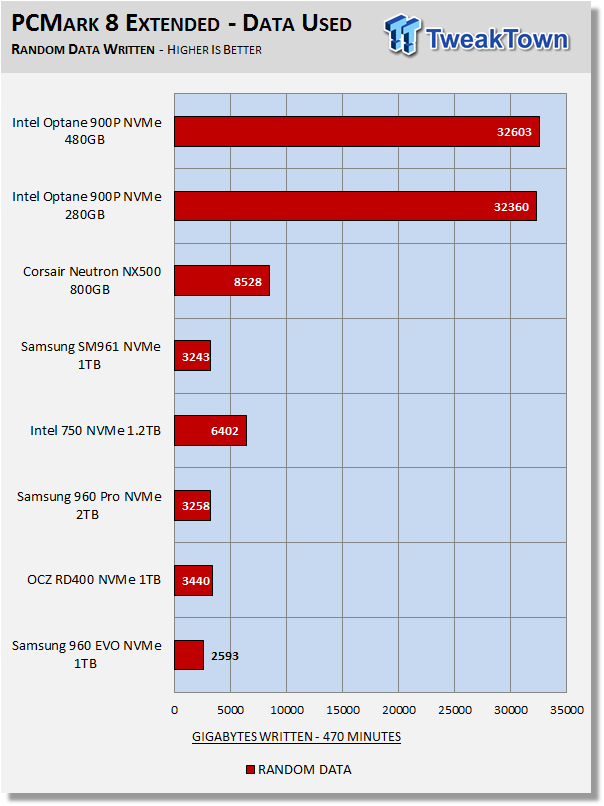
Optane digests a continuous stream of random data far better than any flash-based SSD, writing an incredible 32 terabytes of random data in in 470 minutes.
Benchmarks 70/30 Mixed Workload & Sustained Seq. Write
70/30 Mixed Workload Test (Sledgehammer)
Version and / or Patch Used: Iometer 2014
Heavy Workload Model
This test hammers a drive so hard we've dubbed it "Sledgehammer." Our 70/30 Mixed Workload test is designed to simulate a heavy-duty enthusiast/workstation steady-state environment. We feel that a mix of 70% read/30% write, full random 4K transfers best represents this type of user environment. Our test allows us to see the drive enter into and reach a steady state as the test progresses.
Phase one of the test preconditions the drive for 1 hour with 128K sequential writes at QD32. Phase two of the test runs a 70% read/30% write at QD32, full random 4K transfer workload on the drive for 1 hour. We log and chart (phase two) IOPS data at 5-second intervals for 1 hour (720 data points). 60 data points = 5 minutes.
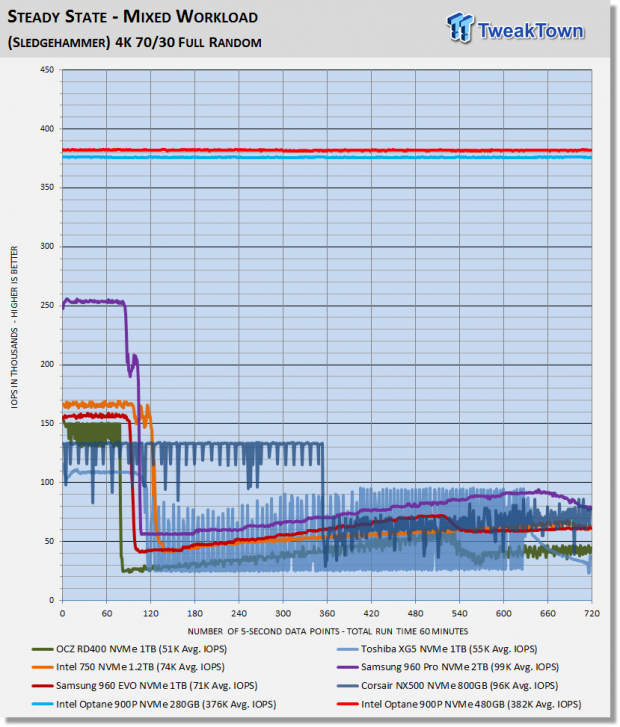
What we like about this test is that it reflects reality. Everything lines up, as it should. Consumer drives don't outperform Enterprise-Class SSDs that were designed for enterprise workloads. Consumer drives based on old technology are not outperforming modern Performance-Class SSDs, etc.
More than any other test we've run, this test best illustrates the advantage 3D XPoint memory has over NAND. Unlike NAND, 3D XPoint is unaffected by the state of the drive during a workload. The 900P turns our Sledgehammer into a Qtip.
Sustained Sequential Write
Version and / or Patch Used: Iometer 2014
Heavy Workload Model
We write to the drive for 1 hour with 128K sequential writes at QD32. We log and chart megabytes per second data at 5-second intervals for 1 hour (720 data points). 60 data points = 5 minutes.
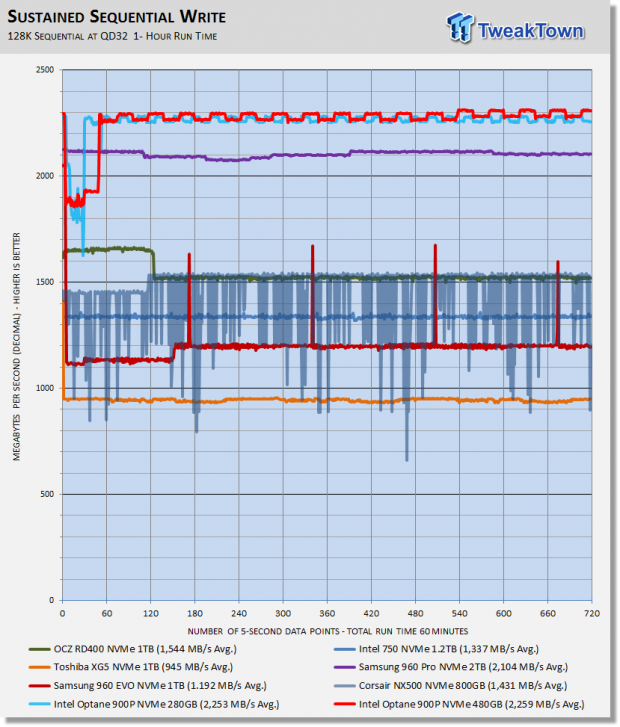
At QD32, the 900P surprises us by delivering a higher sustained sequential write rate than Samsung's 960 Pro.
Maxed-Out Performance (MOP)
This testing is just to see what the drive is capable of in an FOB (Fresh Out of Box) state under optimal conditions. We are utilizing empty volumes of Windows 10, Windows Server 2012/2008 R2 64-bit for this testing.
Windows 10 MOP
Intel Optane SSD 900P 280GB AIC PCIe NVMe SSD
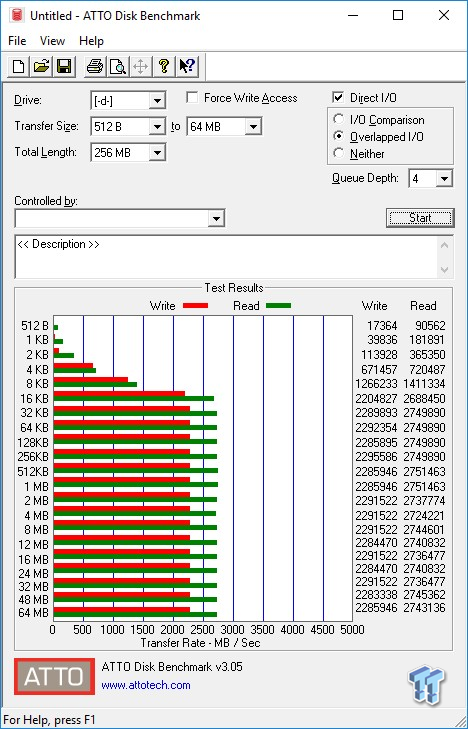
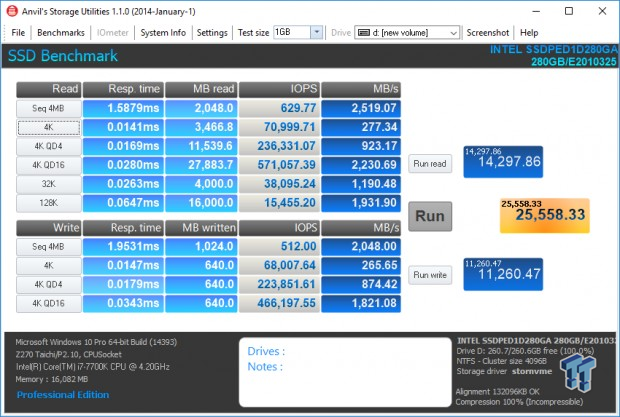
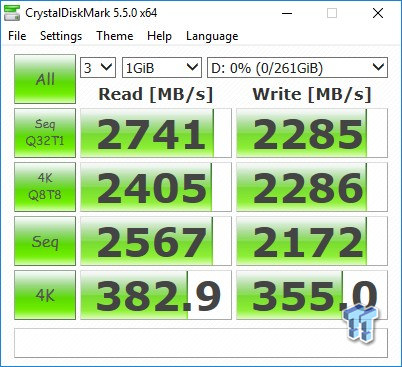
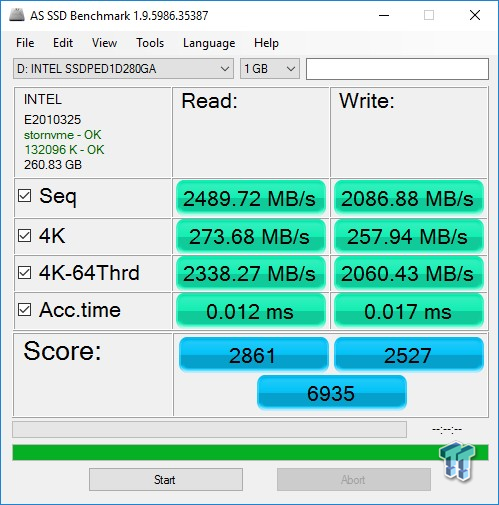
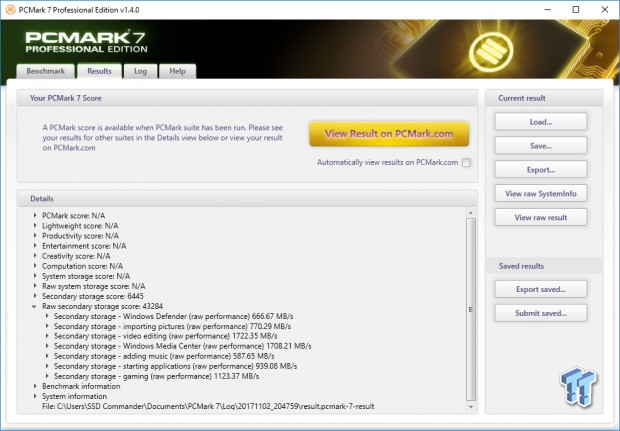
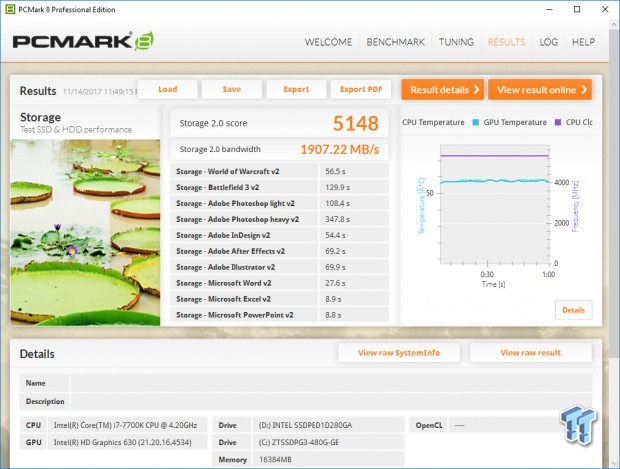
Windows Server 2008 R2 MOP
Intel Optane SSD 900P 280GB AIC PCIe NVMe SSD
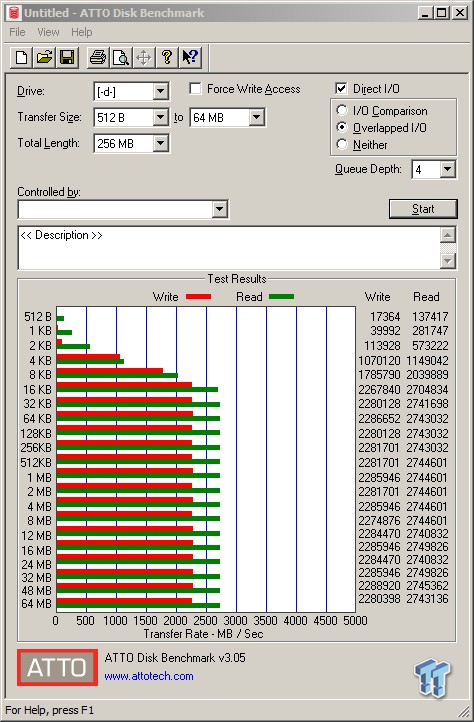
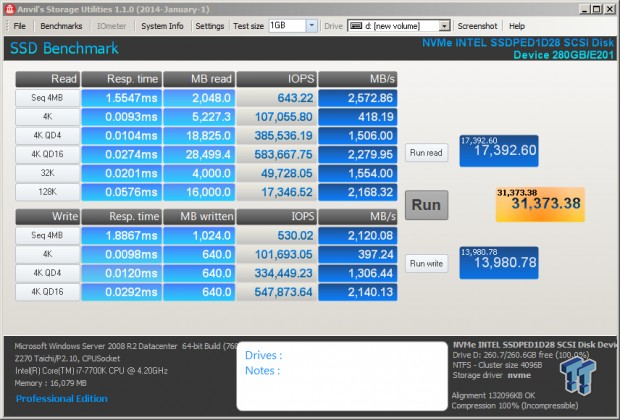
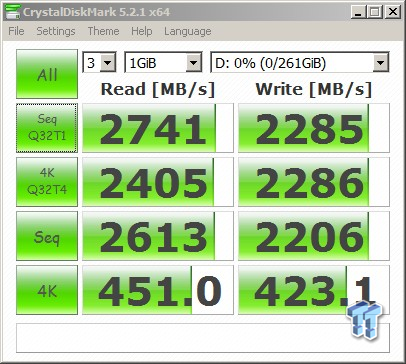
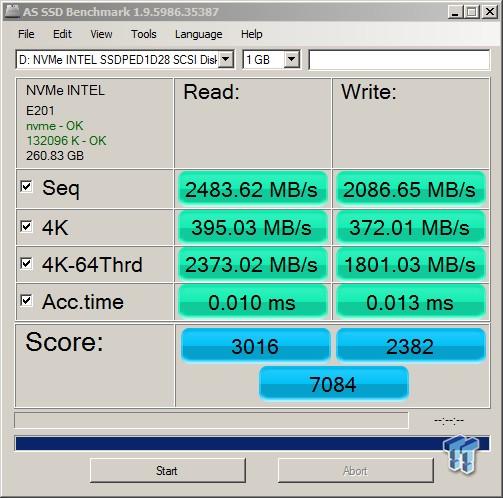
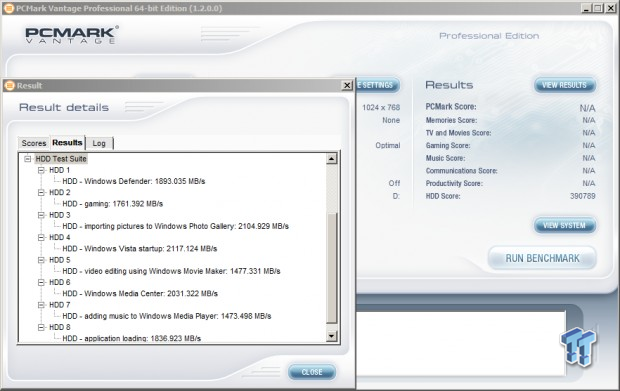
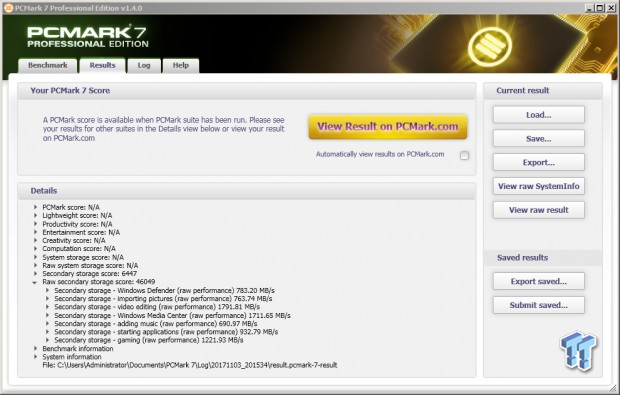
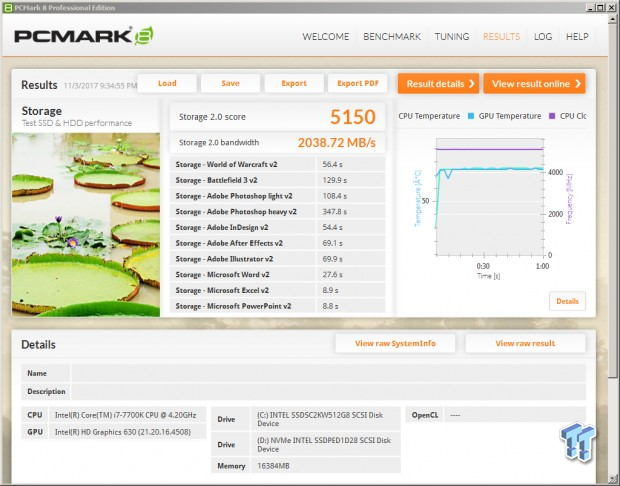
Windows 10 MOP
Intel Optane SSD 900P 480GB AIC PCIe NVMe SSD
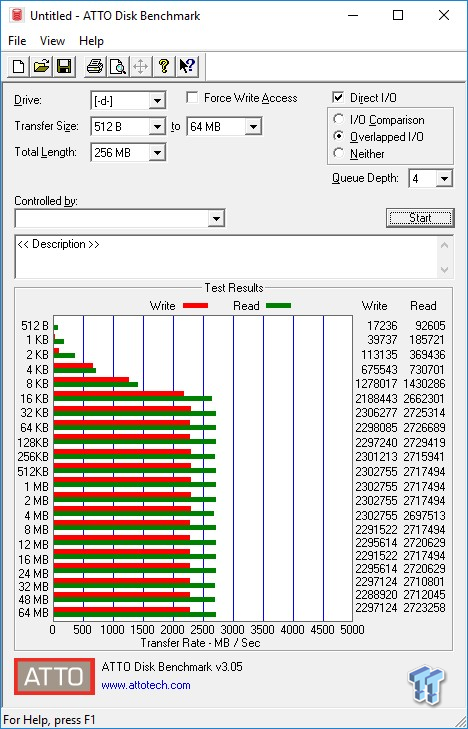
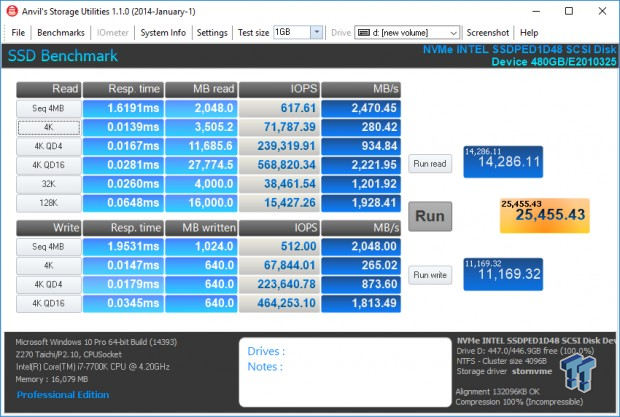
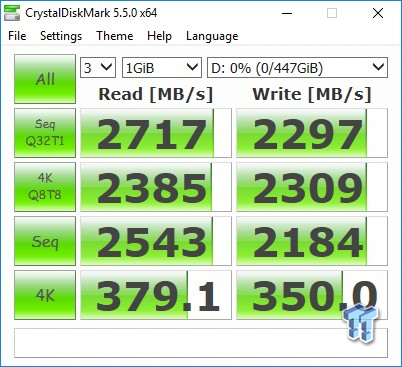
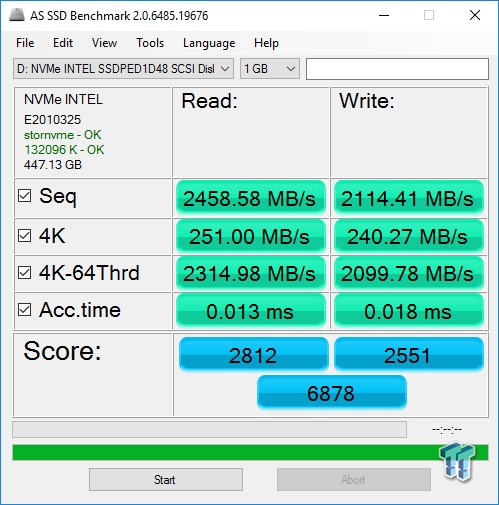
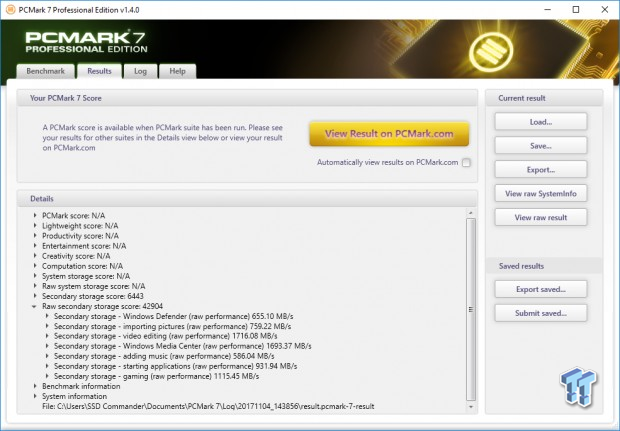
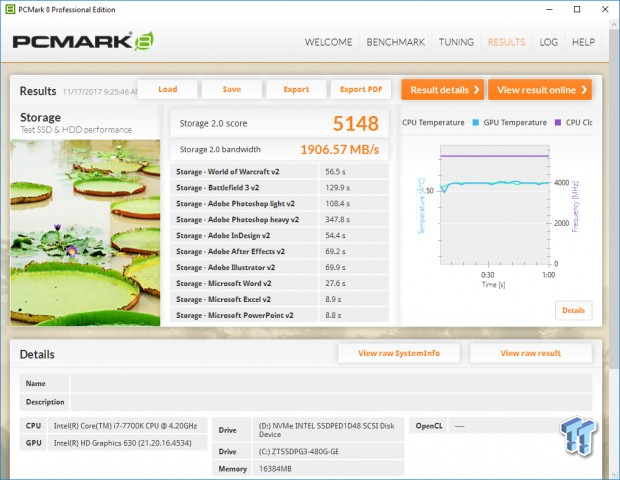
Windows Server 2012 R2 MOP
Intel Optane SSD 900P 480GB AIC PCIe NVMe SSD
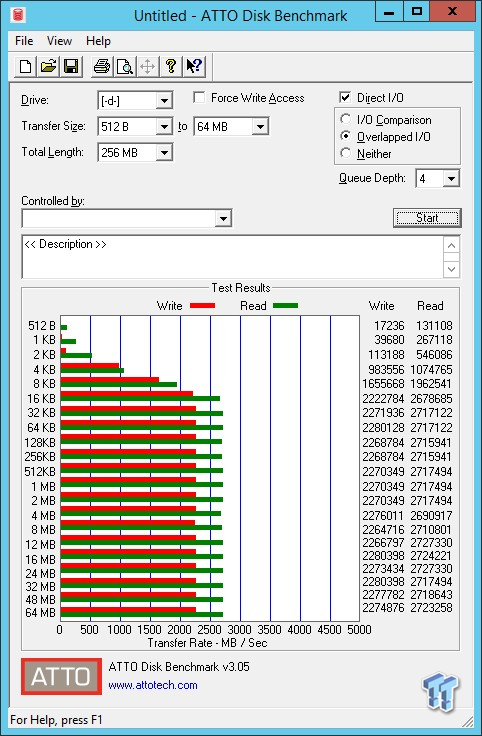
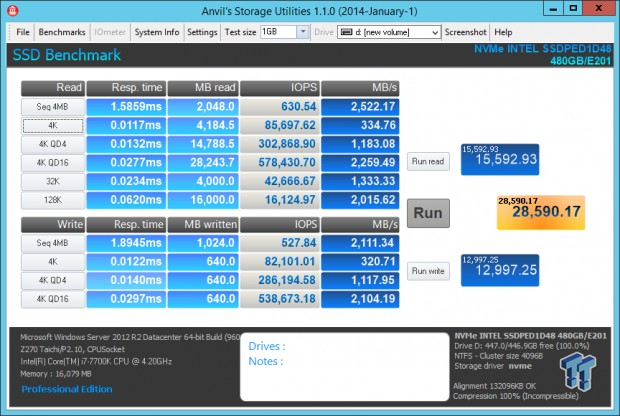
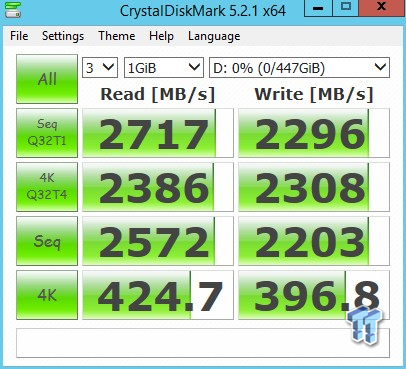
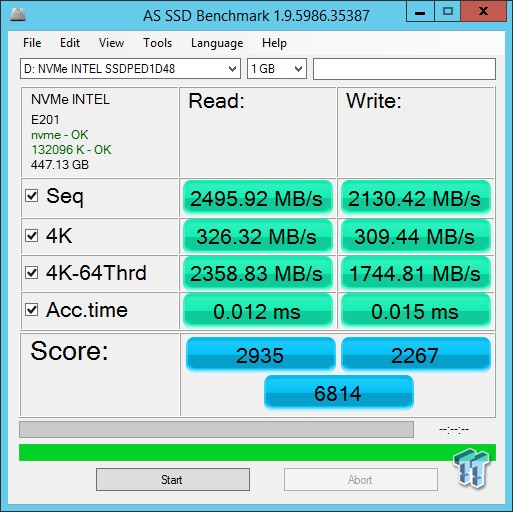

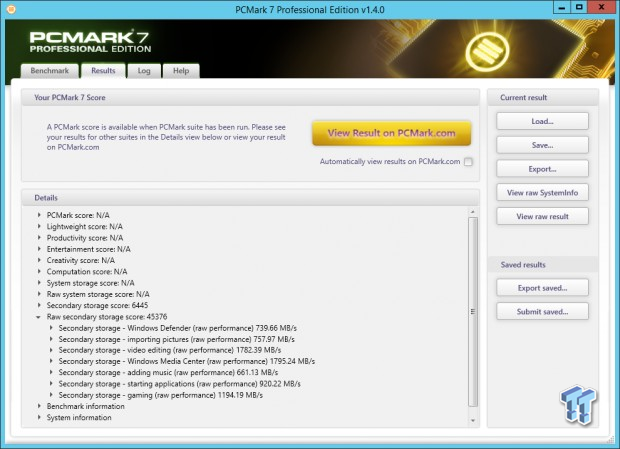
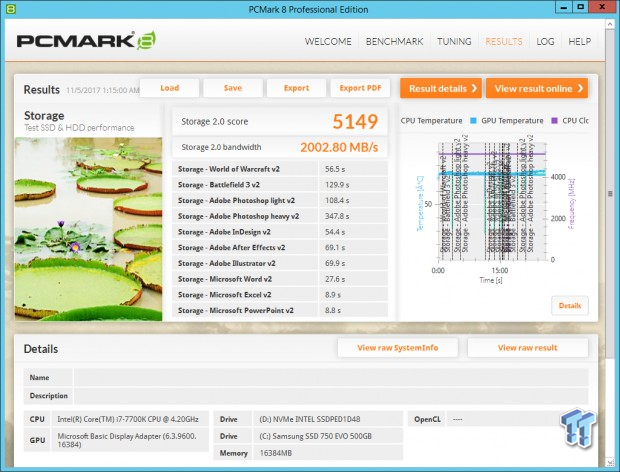
Windows Server 2008 R2 MOP MS SoftRAID
Intel Optane SSD 900P 280GB & 480GB AIC PCIe NVMe SSD MS SoftRAID
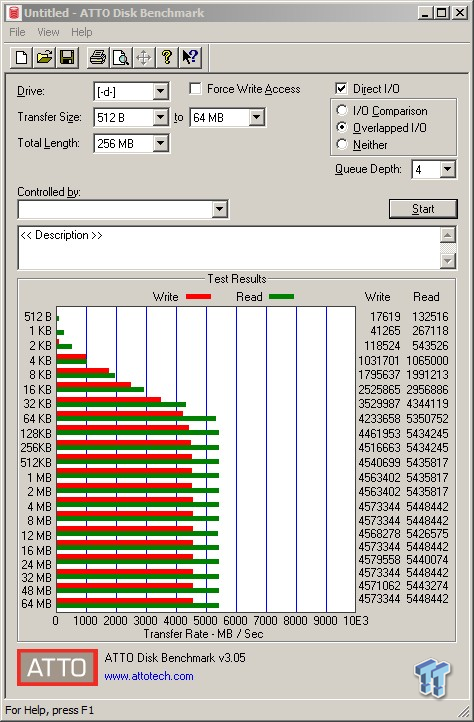
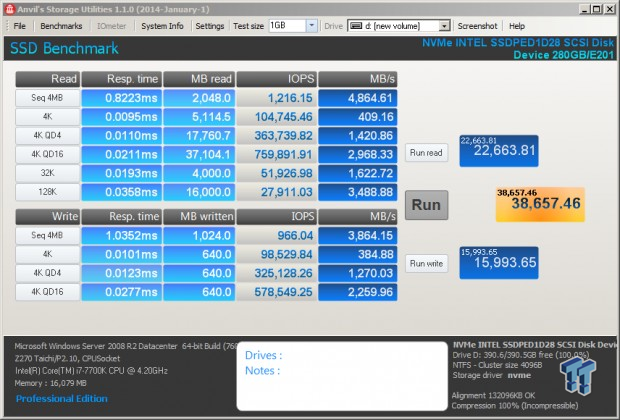
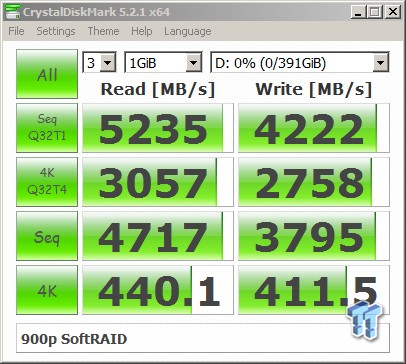
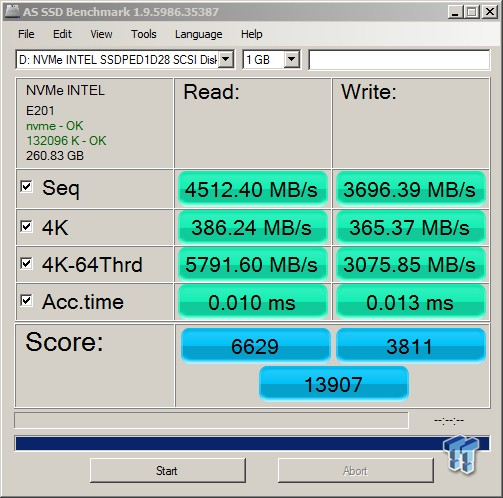
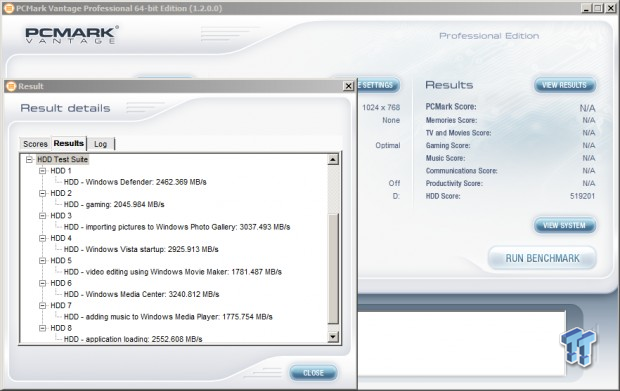
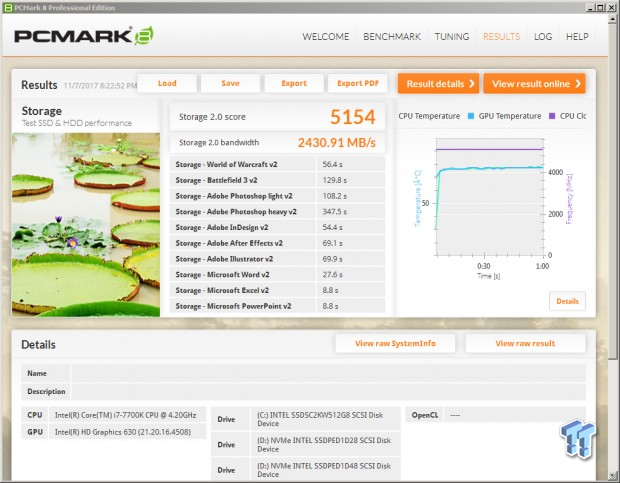
Not bootable, but still much better performance than you will get from a bootable VROC array.
Final Thoughts
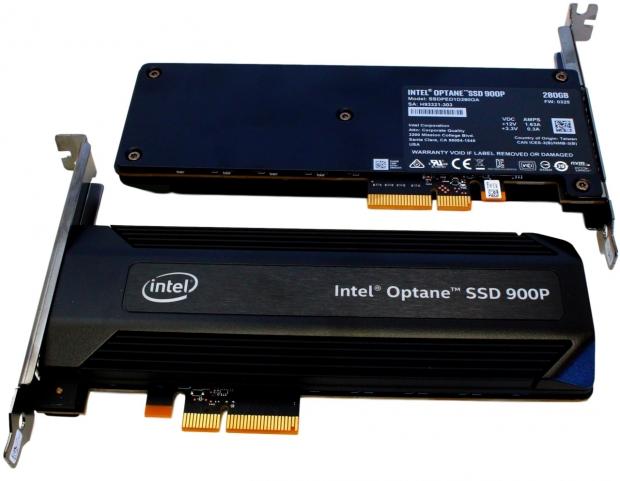
So, here we are experiencing a "New Normal", and it feels great. Intel's Optane SSD 900P does meet or exceed every claim made by Intel, and 3D XPoint is the reason. 3D XPoint memory media virtually eliminates all the shortcomings of flash. In some ways, it functions more like a traditional spinning HDD. There is no need for TRIM, in fact, it is recommended to disable it. There is no garbage collection because 3D XPoint is write in place. There is no need to secure erase to restore performance. It runs great with the standard NVMe driver. Unlike an HDD or flash-based SSD, the Optane SSD 900P does not slow down as the drive fills up.
Additionally, just as SSDs are an order of magnitude more reliable than mechanical HDDs, Optane SSDs are an order of magnitude more reliable than their flash-based counterparts. The main reason Optane SSDs are much more reliable than flash-based SSDs is due to the superiority of the memory media itself, but there is another reason as well - no DRAM cache. A DRAM cache is potentially another point of failure requiring capacitors to protect against host power-loss.
We really cannot overstate the importance of random read at low queue depths to overall system performance. 4K random reads at QD1 make up the majority of disk activity in the consumer space. This is why Optane is revolutionary. It delivers 5-7x the random read performance of the best flash-based SSDs at 4K QD1. And, if you have been paying attention to that metric over the years, the needle hardly ever moves. We are always stuck at about 50-60 MB/s with the best flash-based SSDs whether they are SATA or NVMe.
In fact, as we pointed out earlier, SATA and flash-based NVMe SSDs deliver about the same user experience because they typically deliver roughly the same random read performance at QD1-QD2. Compare that to the 300-375 MB/s 4K QD1 random read performance served up by the Optane SSD 900P, and the reason why Optane is being heralded as game-changing becomes crystal clear.
In terms of pricing, the Optane SSD 900P will definitely cost you more per gigabyte than a flash-based NVMe SSD, but so will any new ground-breaking technology. The old saying "you get what you pay for" applies here especially well. When you buy Optane, you are getting the very best in every way. Just look at those benchmarks! Optane isn't just slightly faster, its 2-4x faster everywhere it matters. Look at the endurance. 5.1 and 8.7 PETABYTES of endurance is unheard of in the consumer space. We are avowed enthusiasts at TweakTown, and as such we cannot help but feel that the 900P is actually the best storage value going. Because, what other major piece of hardware can you buy in that price range that is the world's best performer? And, not by a little, but by a huge margin.
Because TweakTown tests SSDs with the drive running as our system (OS) disk we are in a relatively unique position to comment on what matters most - actual user experience. As you can imagine, the user experience you get from the 900P is unrivaled. For the first time ever, we found that if you just use the in-box Windows 10 driver it's not a drag on performance and you get the added benefits of ease of installation and significantly faster boots. Booting the 900P on the Windows 10 NVMe driver is the best boot experience we've ever had.
Needless to say, the Intel Optane SSD 900P is 100% TweakTown recommended.
Pros:
- Best Performance
- Best Endurance
- Premium Components
- Sleek Design
Cons:
- Availability

